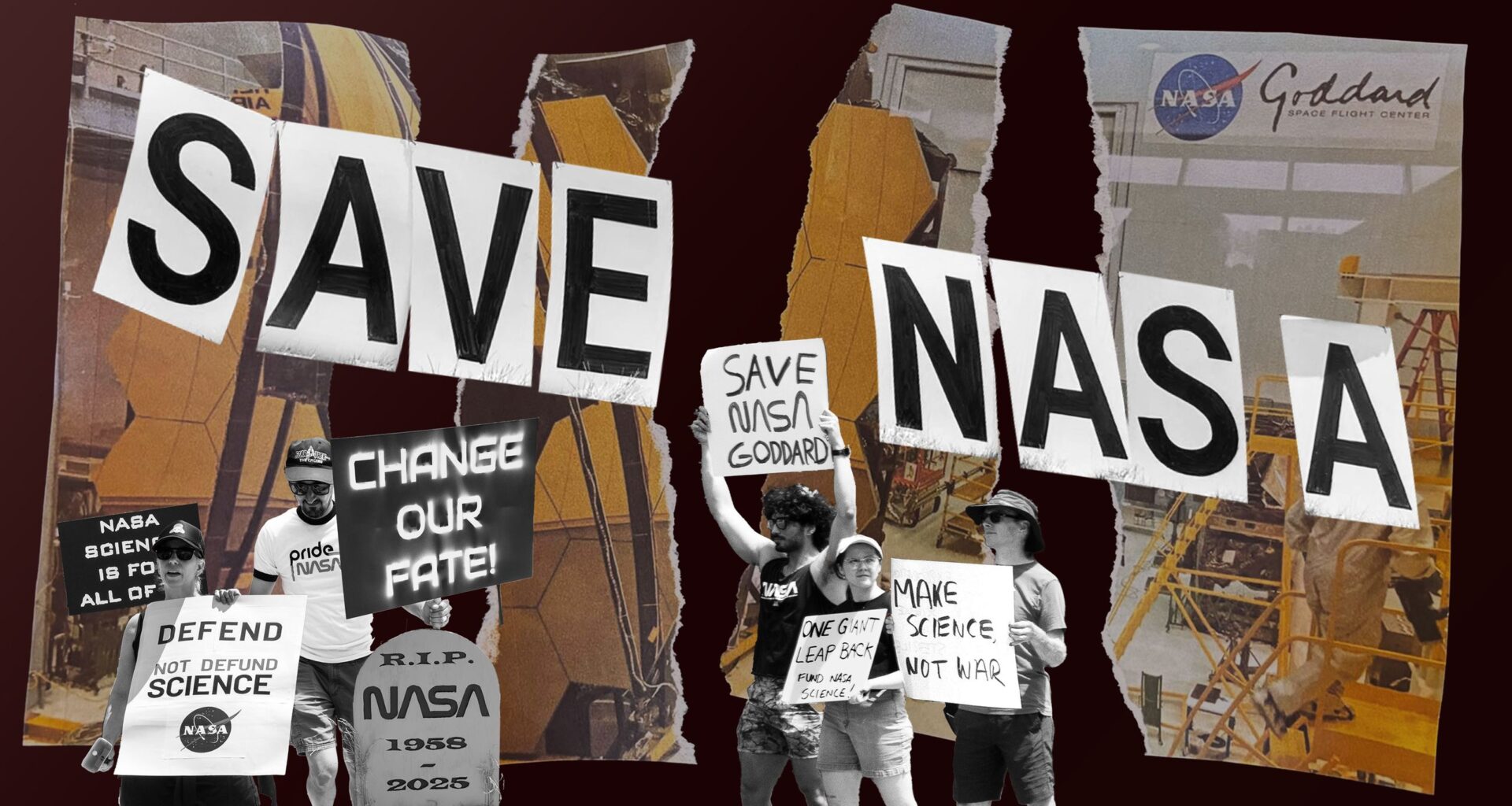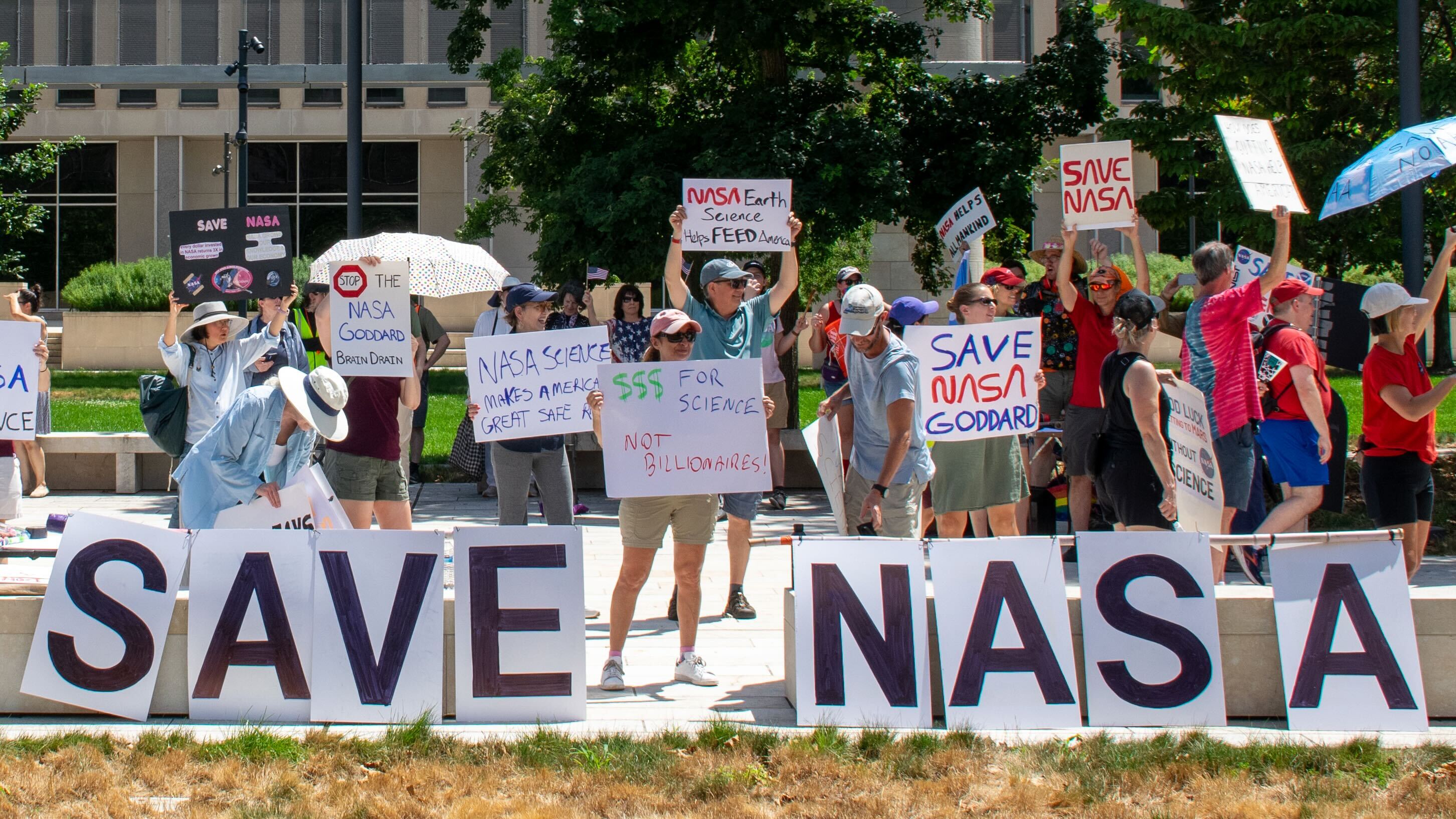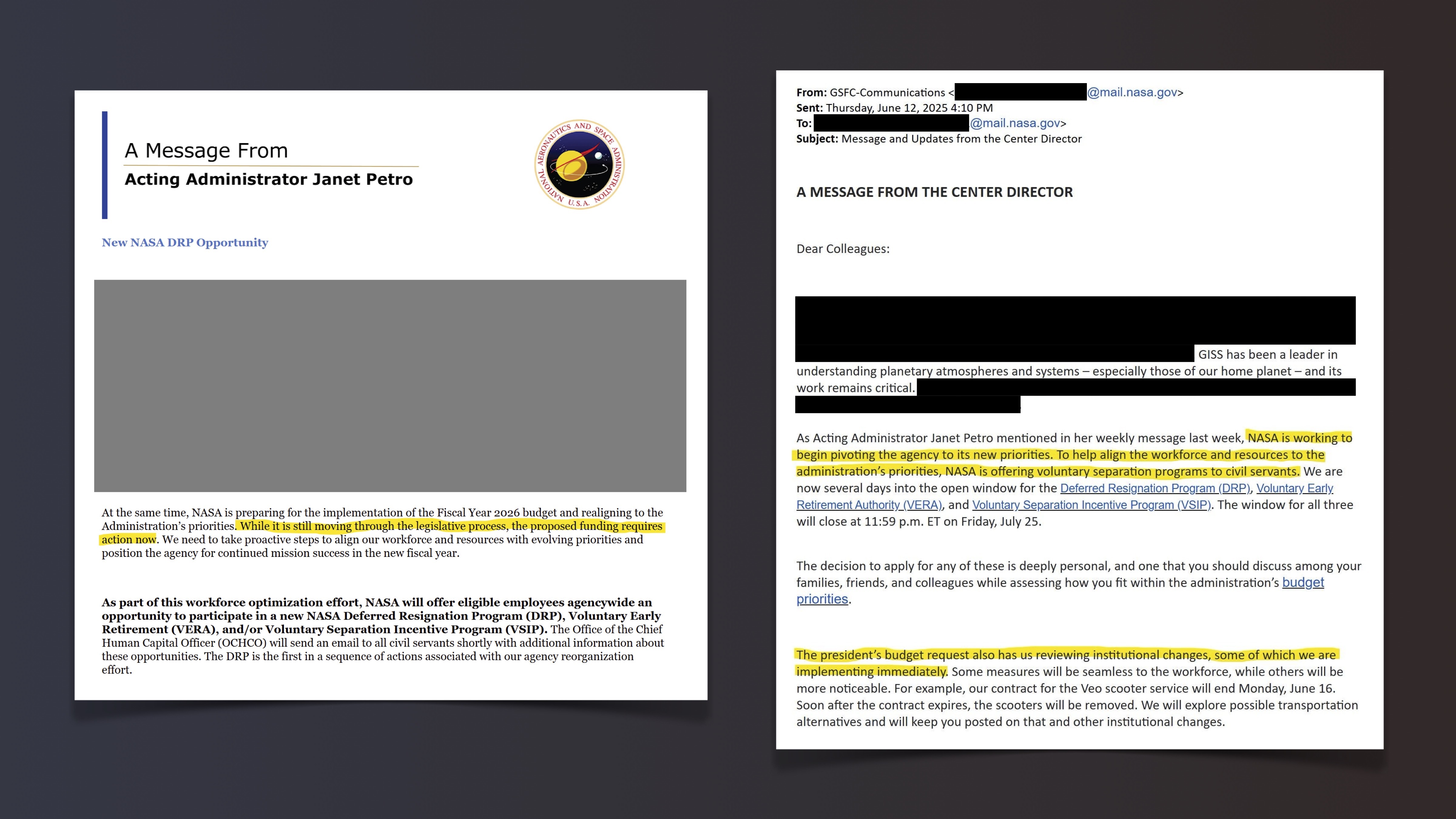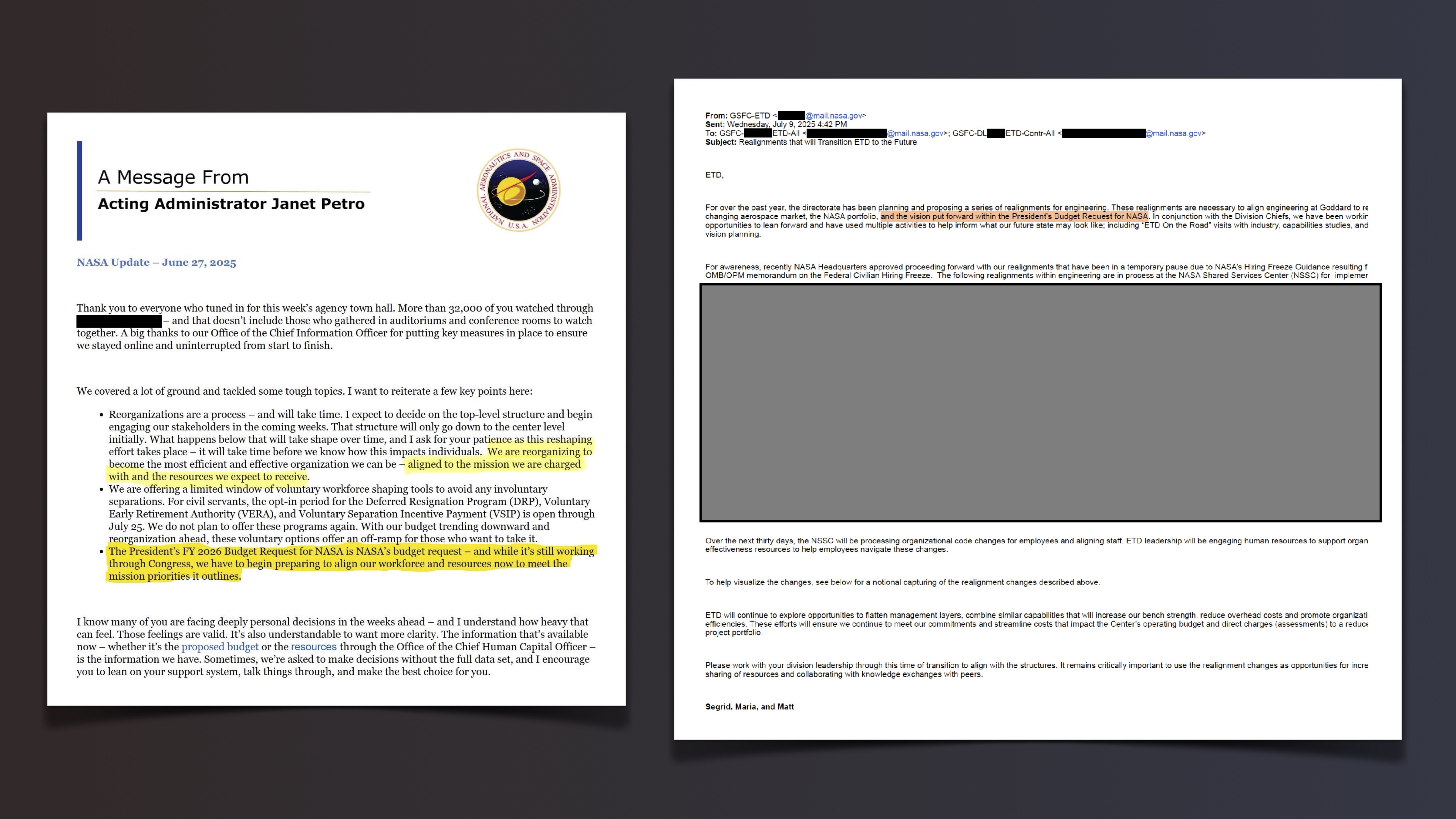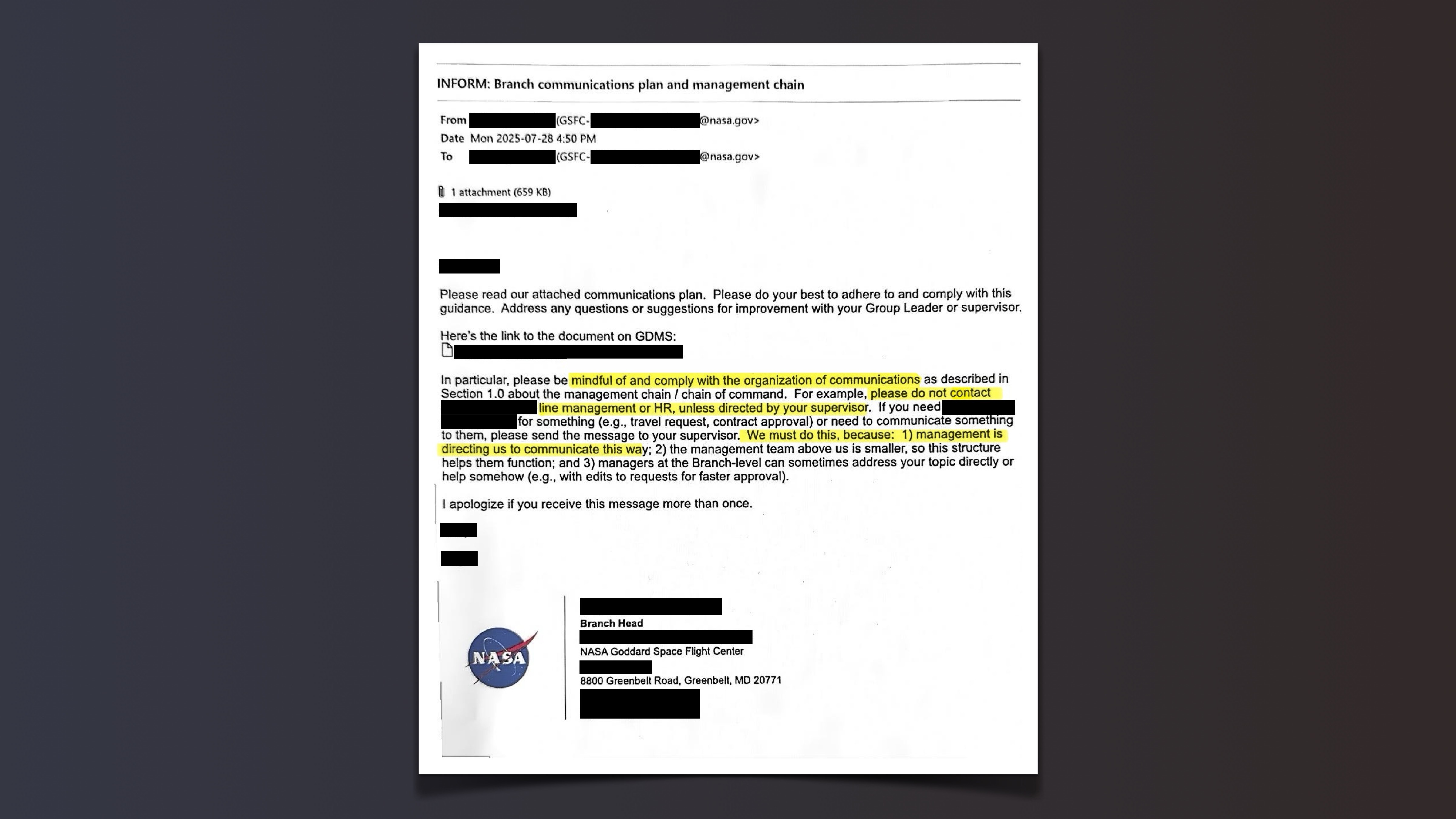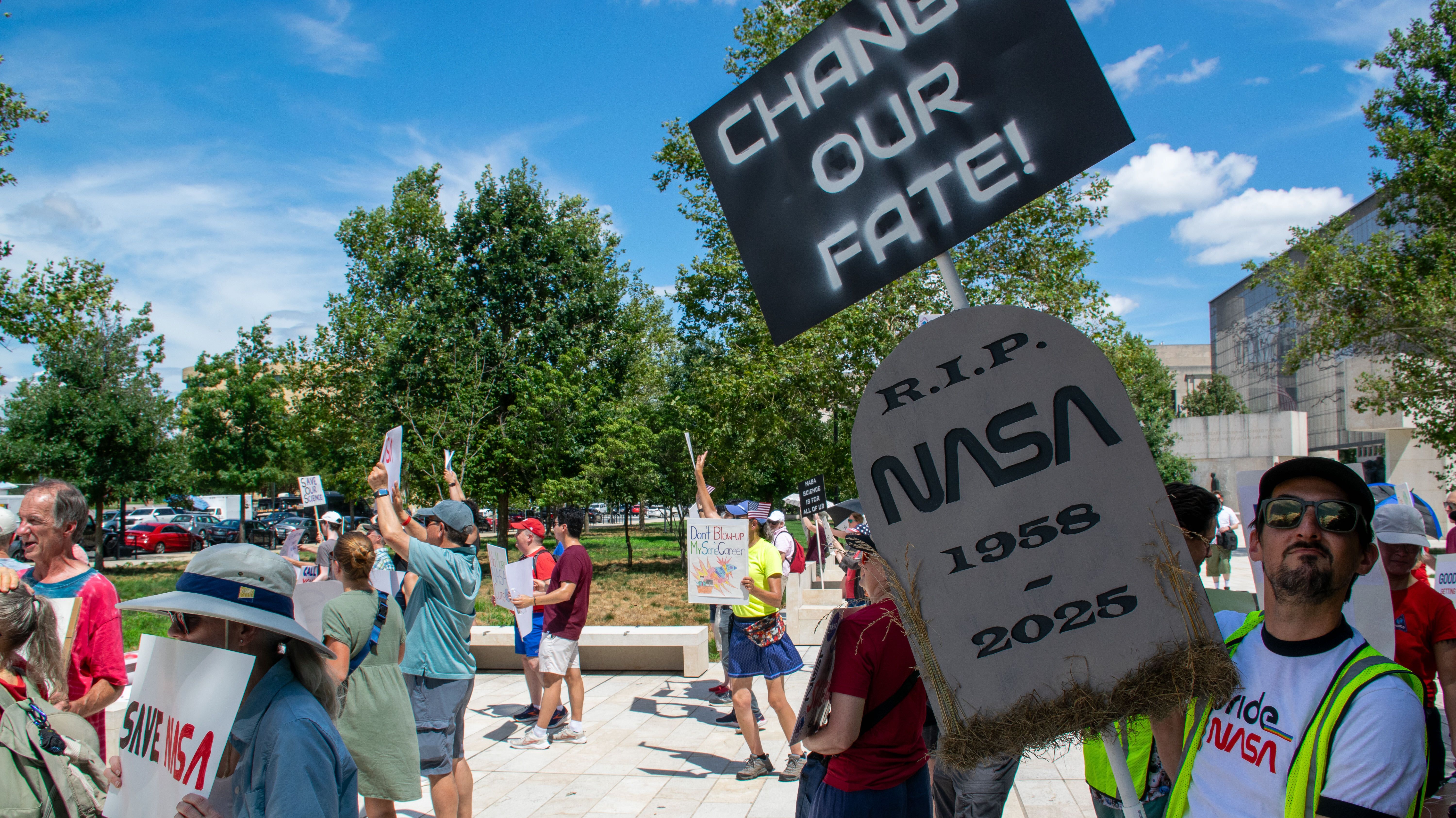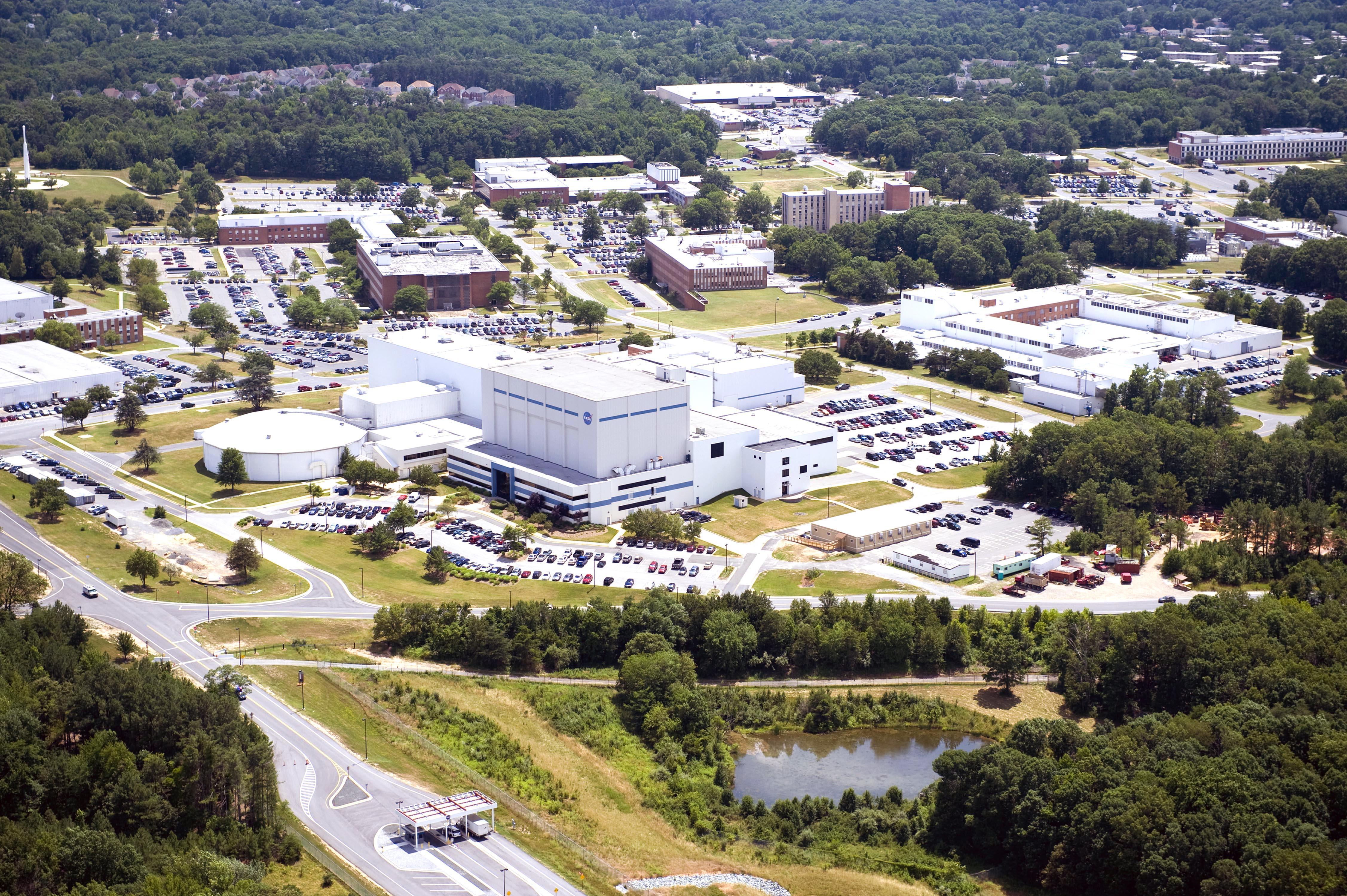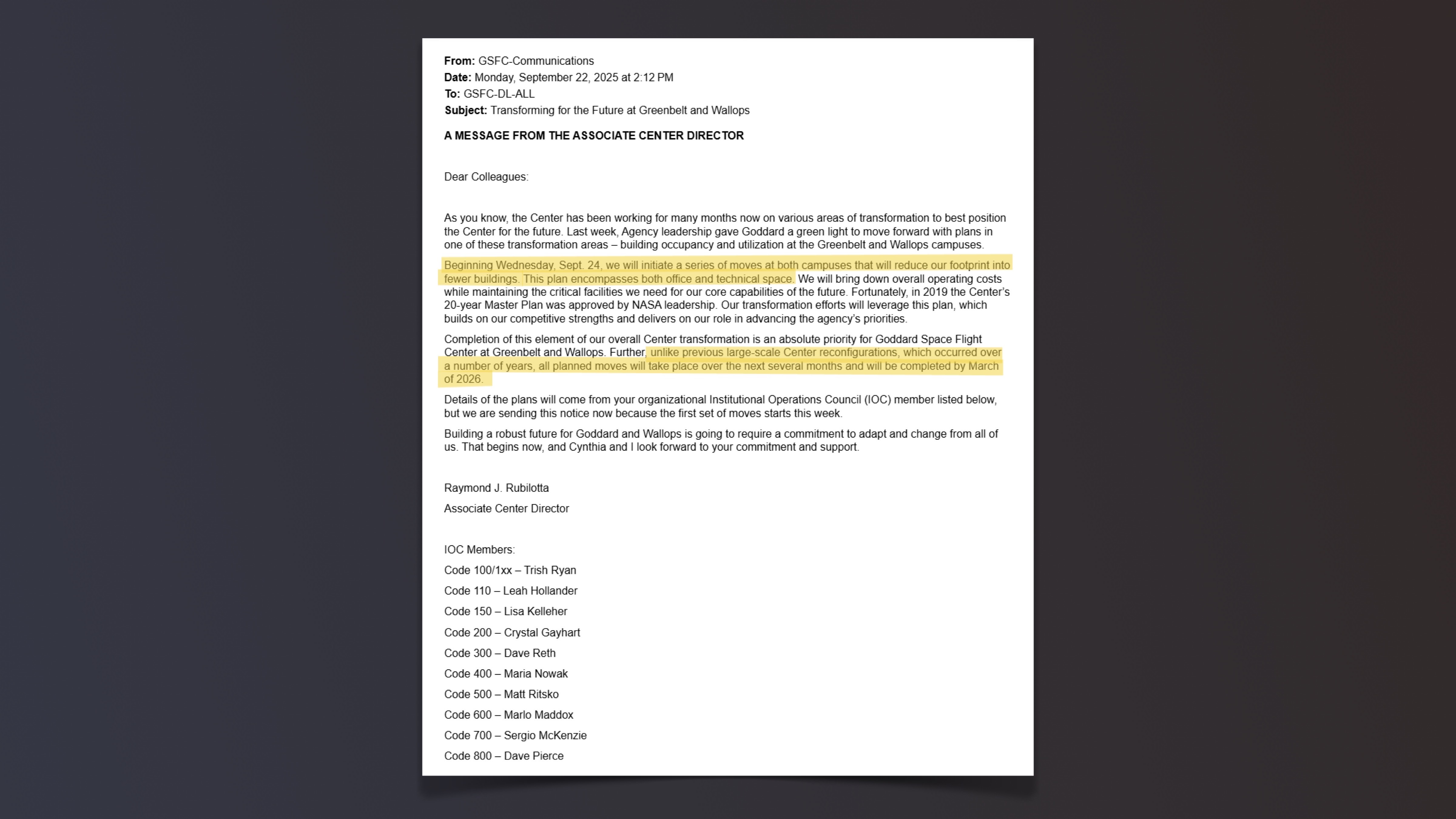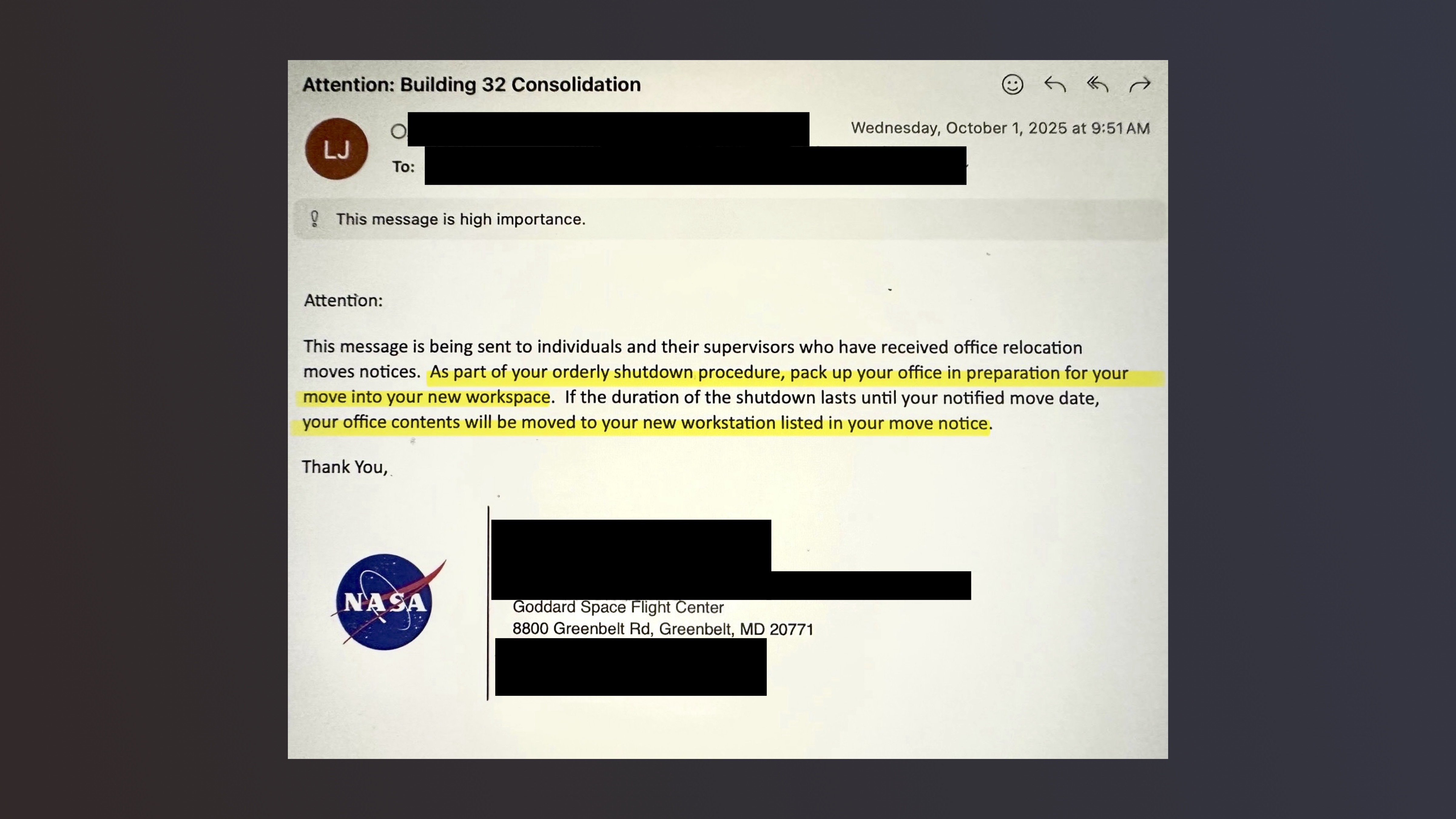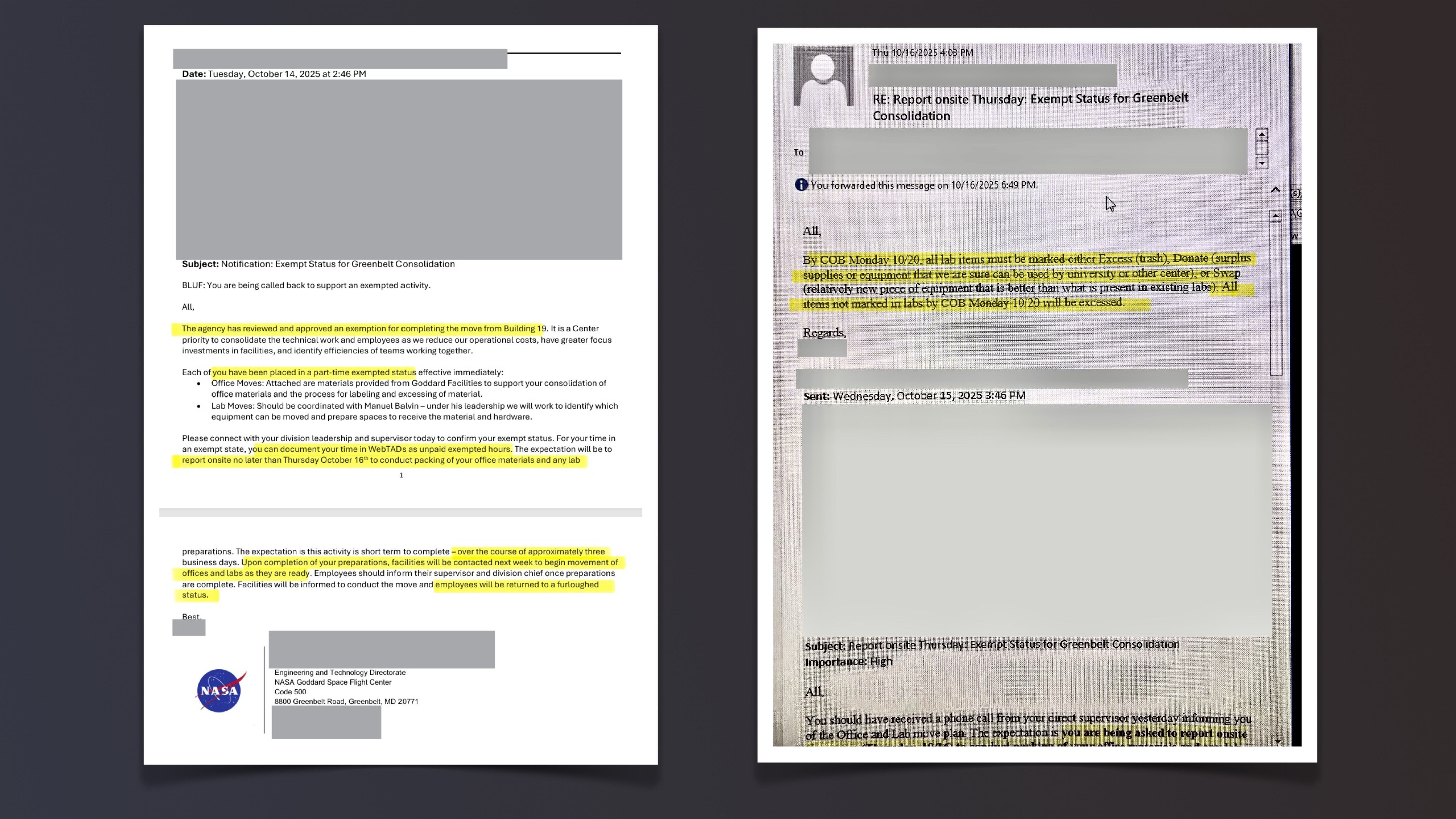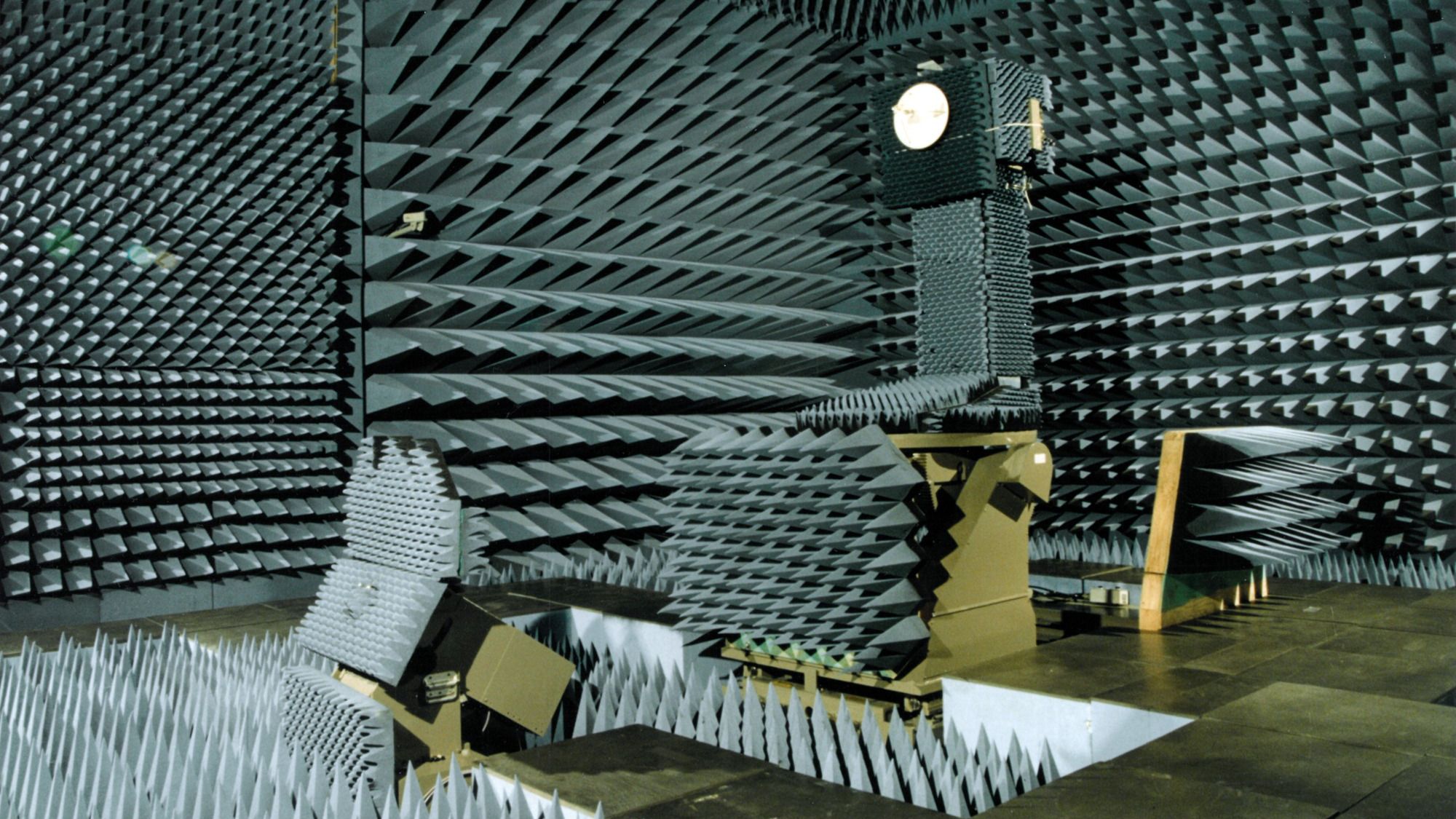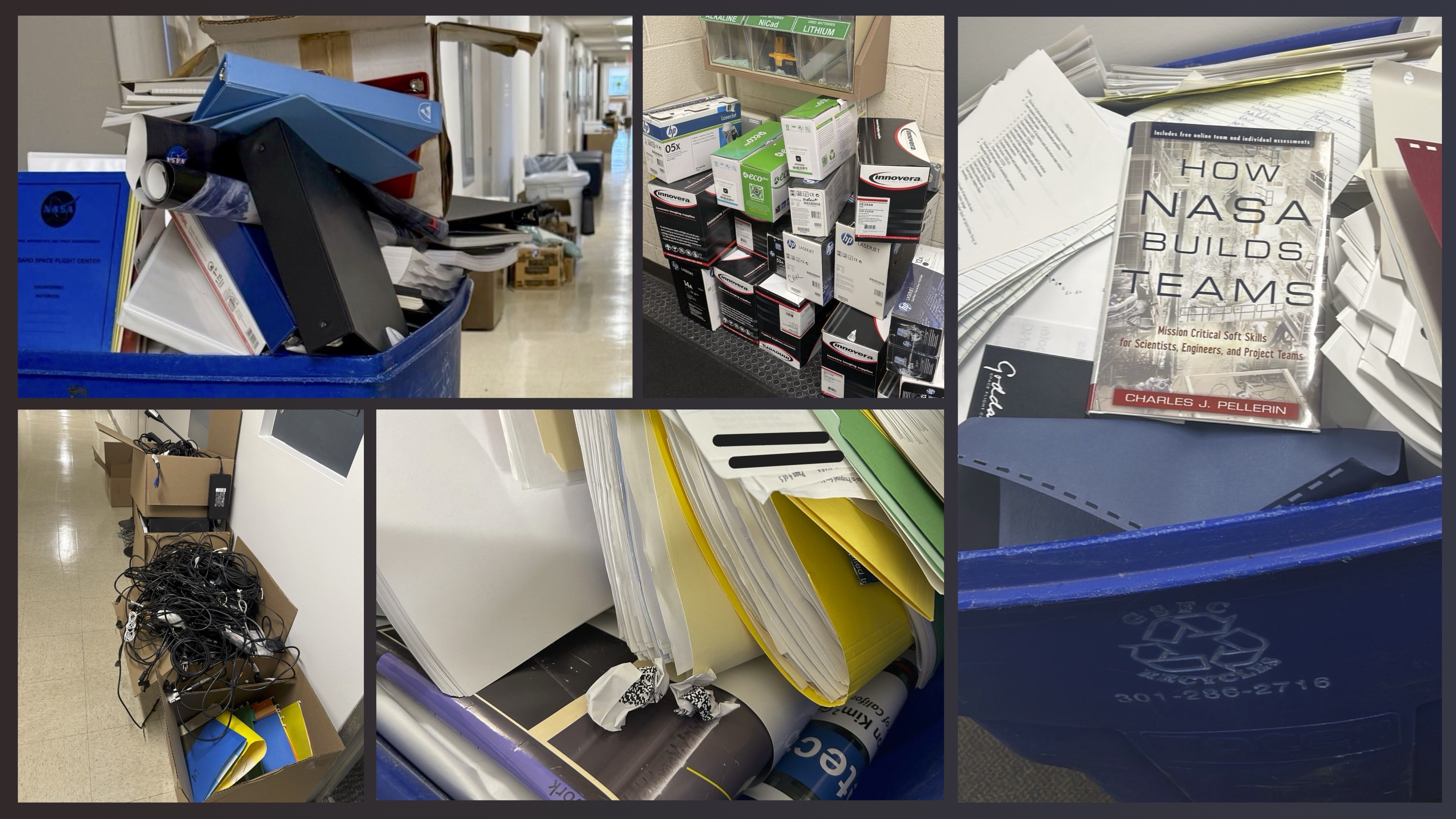NASA’s flagship center for space science is under attack from within, and some of the biggest losses appear to be happening behind the curtain of the government shutdown.
Throughout the summer of 2025, Space.com interviewed nearly a dozen current and former NASA workers and reviewed several internal agency communications in an investigation into allegations of unlawful activity by NASA leadership — allegations supported in a recent report by the U.S. Senate Committee on Commerce, Science, and Transportation. The conclusion: NASA has been prematurely and illegally implementing the President’s 2026 budget request before Congress finalizes funding.
The workforce at NASA’s Goddard Space Flight Center (GSFC) in Greenbelt, Maryland, say this has put groundbreaking missions at risk, and is degrading roadblocks designed to safeguard human lives. Now, under the cloak of a closed U.S. government, nearly half the GSFC campus — the hub of NASA science — is marked for abandonment.
Shifting policies on diversity, science and education that began at the start of Trump’s second term have hit Goddard especially hard. Priorities outlined in the White House’s fiscal year 2026 (FY26) budget request in May, which has yet to be approved by Congress, were embraced as if it were already law by GSFC leadership, who have been preemptively reorganizing center staff and facilities since its release.
Goddard has a target on its back
Goddard has worked on some of NASA’s most iconic space science missions, including the James Webb Space Telescope and the Hubble Space Telescope, which continue to provide groundbreaking astronomical discoveries, and OSIRIS-REx, NASA’s first asteroid sample-return mission. It’s also where NASA is tackling ambitious new missions like the Nancy Grace Roman Space Telescope, the Laser Interferometer Space Antenna (LISA) to detect gravitational waves and measure ripples in space-time, and the Venus atmospheric probe DAVINCI.
GSFC hosts the largest single concentration of researchers in the NASA workforce, encompassing the agency’s Science Mission Directorate (SMD) and Engineering and Technology Directorate (ETD). Nearly 10,000 scientists and engineers work at Goddard in total, around 7,000 of whom are employed through NASA contractors. Center staff said they felt what they perceived as the new administration’s vitriol for science early on.
“The atmosphere, from my perspective, at least, has been incredibly dark and depressing,” Goddard astrophysicist Casey McGrath told Space.com, clarifying that he was not speaking on behalf of NASA or his agency contract employer. “I feel like the people I work with, myself included, have just been demoralized, exhausted, terrified, frustrated and angry, for months and months on end with no pause whatsoever.”
The internal cultures of NASA centers across the country have evolved to align, at least in part, with the political leanings of their respective locales. With Goddard based in a Democratic state under a Republican administration, many there feel as though the space center is being singled out.
Casey Dreier, chief of space policy at the space science and exploration advocacy nonprofit The Planetary Society, explained the divide during a Sept. 18 livestream about NASA’s ongoing budget saga.
“There’s been a really notable divergence and concentration within NASA, almost purely by a historical accident of its major internal directorates and responsibilities, where human spaceflight NASA centers have become very solidly Republican represented, at least at the state level, and NASA science centers have become very Democratic represented at the state level,” Dreier said.
“My title is Research Physical Scientist … even though I’m actually a climate scientist. Apparently the c-word just sets some people off.”
— Claire
It’s a perception shared by many Goddard employees. “Claire,” who asked that her real name remain anonymous for fear of retribution, is a climate scientist at the Goddard Institute for Space Studies (GISS) — a branch of the Maryland campus that, until earlier this year, occupied a building on the Columbia University campus in New York City. While her primary focus is on climate science, Claire’s official title is Research Physical Scientist. She referred to “climate” as the “c-word,” and a term she and her colleagues constantly felt the need to talk around, rather than say outright.
“It does feel like there is an overlap between the political party in charge of your NASA center and how your NASA center is faring right now,” Claire said. “Goddard is a science-based center with a lot of engineers, and a lot of their missions are canceled out (in the President’s budget request). It’s taking a huge hit to the civil service workforce. It does feel like Goddard is now being singled out.”
In January 2025, former NASA Administrator Bill Nelson stepped down from the position ahead of Trump’s inauguration, making way for the appointment of Kennedy Space Center Director Janet Petro as the agency’s acting administrator. Petro was tasked with steering NASA’s early transition period.
At Goddard, Segrid Harris was appointed ETD director in January and began enforcing rigid expectations that many staff saw as a cultural break from NASA norms.
After that, “the mood started changing almost immediately,” Rose Ferreira, a former Goddard spaceflight analyst who was abruptly laid off during SpaceX CEO Elon Musk’s early DOGE (Department of Government Efficiency) sweep through the federal workforce, told Space.com. “The language that was being used in some of our internal emails was so aggressive. I’ve never seen anything like this from NASA,” Ferreira said at the time.
“I think they know that what they’re doing shouldn’t be put in writing.”
— Wendy
“[Harris] was brought in from the Air Force, and she is very strict on the chain of command, and basically is implementing what center management is telling her to do,” said “Wendy,” a Goddard spacecraft engineer who also spoke on the condition of anonymity for fear of retribution, in an interview.
“When we had DOGE coming on site, we had some supervisors saying that if DOGE asks you for access to your laptop, you should give it to them. Basically, just hand over the keys,” Wendy said. “That direction was implied to come from Engineering management, but not put in writing.”
“It’s really hard for us to get anything in writing from Engineering management, because I think they know that what they’re doing shouldn’t be put in writing,” she added.
Another GSFC civil servant who asked to remain anonymous, “Peter,” said that’s by design. “Goddard management is very good at obfuscating its intentions directly, either through refusal to put any directives in writing or by working through chain of command, such that decisions don’t necessarily reflect back on the individual who ultimately made them.” Peter spoke with Space.com about ongoing building closures taking place at Goddard’s Greenbelt campus, but months before, GISS was identified as the first in a chain of dominos to be knocked down.
GISS: The first to fall
By March, NASA was implementing workforce reductions and closing offices (such as the Office of the Chief Scientist and the Office of Technology, Policy & Strategy). Internal speculation about NASA’s future painted a bleak picture for Goddard and its programs. Meanwhile, the vulnerability of NASA’s climate science programs was being underscored nationally, as former agency leadership raised the alarm.
“The first person that was fired at NASA … was the Chief Scientist and Chief Climate Officer,” Nelson said during an event in Washington, D.C. in April. “I think we need to be concerned about that.”
That concern, it seems, was warranted. Later that month, GISS employees were ordered to vacate their Columbia University building (which many may recognize as the one with the corner diner in the show Seinfeld). Since then, they’ve been forced to work remotely — at a time when the government was doling out return-to-office mandates — preventing access to labs and crippling the center’s mission of embedding NASA climate scientists within international academia. Though the closure came as a shock, the reasoning behind it seemed obvious to those on the ground.

The NASA GISS building in New York City. (Image credit: NASA)
“We have one of the original models for climate simulation,” Claire explained. GISS develops and maintains research on atmospheric composition and long-term climate change, and manages NASA’s global surface temperature record — one of the world’s key climate datasets.
“We have the ignoble distinction now of being the second NASA center ever closed down,” Claire said. NASA’s Electronics Research Center in Cambridge, Massachusetts, was the first, shuttered in 1970 due to budget cuts during the restructuring of the Apollo program.
Jim Green, a former NASA Chief Scientist who retired in 2022 after 42 years at the agency, told Space.com that stewardship of that climate research requires a significant undertaking.
“The huge Earth science workforce at Goddard analyzes an enormous amount of Earth science data that comes in … That requires quite a cadre of very knowledgeable people,” Green said. “Not only the project scientists and the scientists analyzing the data coming from those missions, but also the scientists that are managing multi-mission analysis. That’s particularly true in Earth science.”
Green said climate and Earth science have a big footprint at NASA. “Earth science in particular has a huge, huge infrastructure analyzing our Earth satellites. So I think they, of course, have been hit disproportionately because of the approach the administration is taking,” he said.
The move out of the GISS building was chaotic. Equipment for one NASA mission, PACE (Plankton, Aerosol, Cloud, ocean Ecosystem) — a satellite launched in February 2024 that measures the health of Earth’s oceans — had to be hurriedly moved between agency sites to avoid program setbacks.
“There was about, I don’t know, a million dollars worth of [PACE] equipment,” Claire estimated. “They told us to get out of the building … So the PI (principal investigator) rented a car, and he put all of the stuff in the car and drove through the night to put it on another NASA facility so that it’d be safe.”
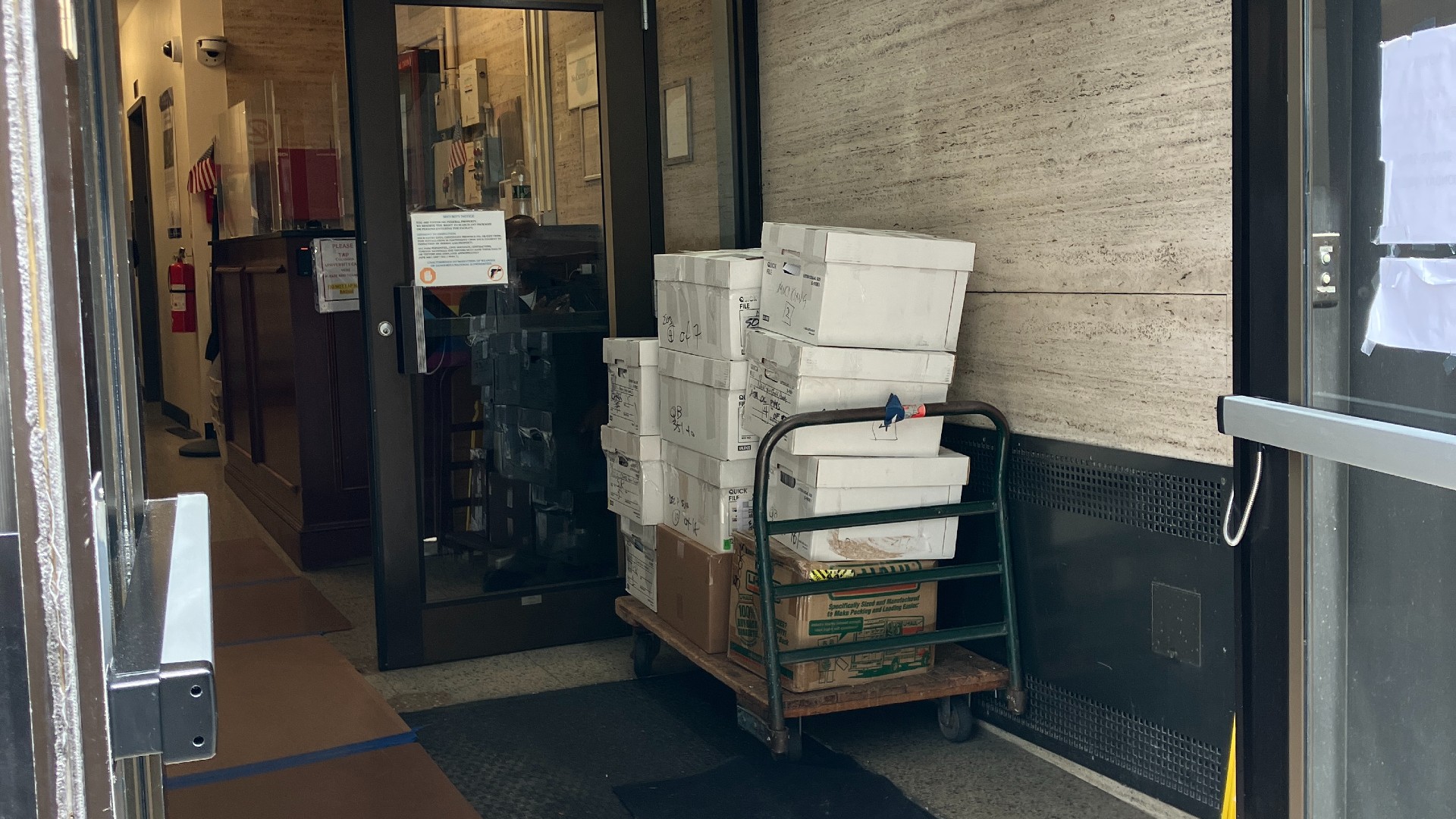
Stacks of boxes containing files from NASA’s Goddard Institute for Space Studies being moved into storage. (Image credit: Joanna Thompson/Future)
GISS’s position on a university campus allowed for a unique relationship between the facility and academia. Only about a third of the people who work at GISS are federal employees or federal contractors. The other two-thirds work for Columbia and other universities. “They are those soft-money scientists who are totally supported by those federal research grants,” Claire said.
“They didn’t fire us, but they didn’t have to fire us,” Claire said. “All they have to do is stop putting money into federal research grants, and it will have the same impact without any of the stop measures that you have for the federal civil service. Those do not exist in the academic community for the federal research grants.”
While they still have work to do, their ability to do it is being siloed. “When it comes to doing cutting-edge science, having a little bit of face time goes a really long way,” Claire explained. “The cross talk, the back-and-forth that you cannot have during Zoom meetings — during face-to-face meetings, you can. You actually make a lot of progress,” she said. “That’s all gone. And so this piece of our mission, which was to be integrated into the academic community — we’ve been cut off at our knees.”
Claire used Climate Week NYC, an event celebrated at the end of September, as an example of opportunities missed as a result of the new constraints. “There are people coming to New York City from across the world,” she said at the time. “If we still had our facility and that was happening, we would have dozens of meetings leveraging our conference centers on site, so that we could be true to our mission … Now, we’re scrambling just to find a space.”
Closing GISS may have also violated NASA’s agreement with Claire’s employee union. Claire is a member of GESTA, the Goddard Engineers, Scientists and Technicians Association. GESTA operates under the umbrella of IFPTE, the International Federation of Professional and Technical Engineers, and advocates for NASA employees’ rights, working conditions and policies.
“As a civil servant, I had a collective bargaining agreement that said certain things had to happen before there could be a change in working conditions,” Claire said. “My collective bargaining agreement was totally ignored when they kicked us out of our building with just a month’s notice.”
Today, the GISS building presumably still sits empty, with NASA apparently continuing to foot the bill.
“The super has told us the building is not rented out,” Claire said. “He thinks it’s still being paid for. They’re not showing it off to anyone else.”
In retrospect, Claire wondered if GISS was a test case for closures at Goddard that came months later, and are happening now.
“They are closing down a significant part of the Goddard campus, and so I think that we [at GISS] were singled out to be the first one to get poked,” she said. “In general, Goddard is not a favorite amongst the NASA centers.”
NASA’s budget eviscerated
Days after GISS employees were given notice to vacate their building, the White House released the FY26 Presidential Budget Request (PBR). It proposed a historic 24% cut to overall NASA funding and slashed the money for space agency science programs by 47%.
Experts called the cuts catastrophic, saying they waste billions in federal investments and gut groundbreaking missions.
“Three words that we’ve been using to describe this: unprecedented, unstrategic and wasteful — wasteful of the taxpayers’ investment,” Jack Kiraly, director of government relations at the Planetary Society, said during the Sept. 18 livestream. The Planetary Society has lobbied to restore NASA’s budget in Congress’s appropriations bill since the budget request’s publication, which cancels 41 planned or already active science missions, including functioning spacecraft operating in Earth orbit and beyond.
Dreier called it an “extinction-level event.”
“This isn’t just poor policy — it’s fundamentally wasteful and inefficient, exactly what this Administration is saying it does not want,” Dreier told Space.com in June. “When you abruptly terminate projects that are already in development, or well-functioning projects operating for pennies on the proverbial dollar, you’re essentially throwing away all the previous investment while gaining nothing in return.”
“The operating missions cancellations alone represent over $12 billion of invested taxpayer value. And once they’re gone, they’re gone. It would take years and many millions more to replace them,” he added.
Another casualty of the FY26 budget request was NASA’s Office of STEM Engagement (OSTEM), which was completely eliminated from the space agency’s portfolio. OSTEM was responsible for NASA’s educational outreach and student involvement in science, technology, engineering and mathematics programs.
“That not only has an effect on what we do at NASA in terms of workforce development, but also kids across the entire country,” said Julie, an agency employee who did not wish to give her last name, told Space.com during a worker-organized demonstration to protest agency science cuts in July. She was not authorized to speak on behalf of NASA.
Julie listed programs like grad school scholarships and teacher training initiatives that will be lost in OSTEM’s absence. “If that’s something that goes away completely, it’s going to impact the entire next generation of students,” she said.
Demonstrators across from the Air and Space Smithsonian protest cuts to NASA science missions, July 20, 2025. (Image credit: Space.com / Josh Dinner)
“We’re not talking about delays in scientific exploration. We’re talking about the end of it.”
— Bill Nye, Planetary Society CEO
Since the FY26 budget request’s release, pushback has been sharp. Employees at Goddard under the banner NASA Needs Help organized three public protests over the summer, and have joined organizations like the Planetary Society and lawmakers to call on Congress to restore NASA’s funding.
At an Oct. 5 day of action on Capitol Hill hosted by the Planetary Society, CEO Bill Nye outlined the stakes. “Fully functioning spacecraft summarily turned off, development work on virtually every future science mission summarily halted. We’re not talking about delays in scientific exploration. We’re talking about the end of it,” he said.
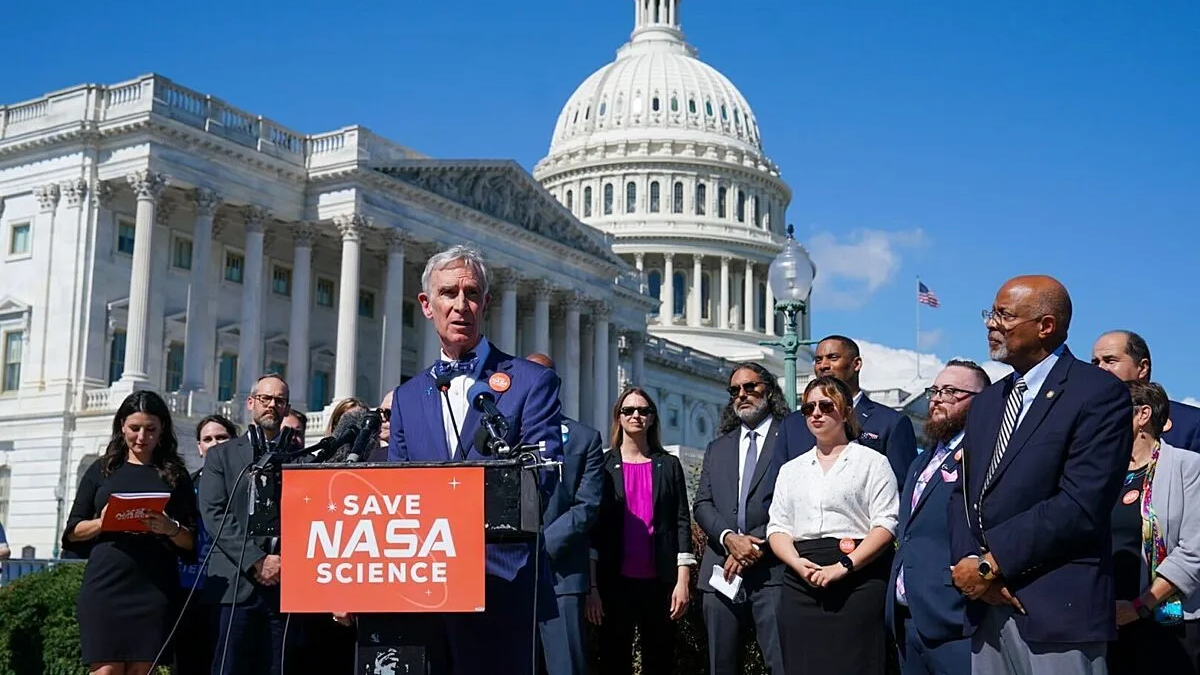
Planetary Society CEO Bill Nye addresses press and supporters on Capitol Hill on Oct. 5, 2025. (Image credit: Planetary Society)
To his relief and others, Congress is pushing back on the proposed cuts.
The Senate Appropriations Committee advanced a measure to fund NASA at a level comparable to fiscal year 2025, and there is bipartisan support for maintaining the space agency’s science programs. But many who protested over the summer worry that irreparable damage has already occurred, and is being accelerated by the government shutdown.
Part of that fear is due to the perception that whatever Congress signs into law won’t matter. Employees assume the Office of Management and Budget (OMB) will illegally impound funds anyway. Some think it’s already happening. “People expect that to continue,” said Wendy, the Goddard engineer. “So they don’t trust that Congress’s budget will actually be implemented even after it’s passed.”
Lawmakers, too, have voiced skepticism about OMB’s actions. In an op-ed published Aug. 5, Republican Representative Brian Babin, of Texas’s 36th district, wrote, “Although Congress is working to ensure NASA has what it needs, the Office of Management and Budget’s proposed budget doesn’t align with Mr. Trump’s directives. To be blunt: OMB needs to start rowing in the same direction. We don’t have time for budget games.”
Kiraly, with the Planetary Society, thinks there’s a deeper motivation behind OMB fighting the tide: OMB Director Russell Vought.
“This is not the President’s budget. This is not Congress’s budget. This isn’t even secretary Sean Duffy’s, who’s serving as the acting Administrator of NASA (since replacing Petro in July). This is Russ Vought’s budget,” Kiraly said during the Planetary Society livestream.
Vought, Kiraly said, has it out for NASA. “He is somebody that historically has not seen a lot of value in space science … who does not believe that the government should be investing in space exploration or space science,” he said. “And we know that because just a couple years ago, he very much wrote this exact thing. He wants to propose a 50% reduction to NASA Science.”
Dreier agreed. “The problem with the OMB,” he said, “is not just that they can control the flow of money. They control the rate of spending in addition to preparing these budget requests. So even if you provide them the money, they can throw in a decent number of internal bureaucratic hurdles or slow-walk the pace at which this goes out.”
Early enforcement
The debate over the budget and implementation legalities is still taking place months later. Very quickly after the FY26 budget request’s release, however, NASA leadership started sending messages to staff about reshaping the agency in that image. They announced organization restructurings, impending reductions in force (RIFs) and encouraged space agency employees to take advantage of Deferred Resignation Programs (DRPs).
In a June 9 email obtained by Space.com, Petro instructed staff to start implementing changes to reflect “the Administration’s priorities.”
“While it is moving through the legislative process, the proposed funding requires action now,” the email states. In bold, Petro listed three different programs available to employees who wanted to do their part in thinning NASA’s workforce: the agency’s DRP, Voluntary Early Retirement (VERA) and a Voluntary Separation Incentive Program (VSIP).
Emails from June 9 and 12 show an insistence by NASA leadership to adhere to President Trump’s 2026 budget request. (Image credit: obtained by Space.com)
“We’re already seeing the agency is moving to put in motion things that are laid out in the President’s budget request, even though Congress hasn’t weighed in yet, because they think it’s clear that that is the direction we’re ultimately going to be heading in,” McGrath said in July.
That observation was shared by others at Goddard. “The reason a lot of management says that we have to plan for the President’s budget request, as opposed to Congress’s budget, is because they believe that the President will impound the funds even if Congress passes a budget,” Wendy said.
U.S. Senator Maria Cantwell (D-Wash.), Ranking Member of the Senate Committee on Commerce, Science and Transportation, said what’s happening at NASA is illegal. A Democratic staff report released by Cantwell and the Committee on Sept. 29, titled “The Destruction of NASA’s Mission,” says NASA’s preemptive compliance with the PBR is an “unconstitutional plot to gut the agency” and circumvents Congress’s authority.
“The President’s proposed budget … carries no force of law, cannot override existing spending laws, and has no legal impact on funding appropriated by Congress,” the report says.
“Losing hundreds of NASA scientists and experts with irreplaceable experience — especially at Goddard — as well as permanently shuttering labs, one-of-a-kind equipment and entire buildings, causes irreversible disruptions to core scientific research that will last far into the future and undermine the United States’ global leadership position,” Cantwell told Space.com in a statement.
“We will not win the space race in the long run without fully funding NASA’s science mission,” she added.
Duffy named Amit Kshatriya as NASA associate administrator Sept. 3. After the report’s release, Kshatriya unequivocally denied its claims.

(Image credit: Space.com / Marilyn Perkins, with contributions from Josh Dinner)
“This report is false,” Kshatriya said in a statement to Space.com. “NASA has communicated openly and transparently with Congress that we continue to execute our available appropriated funding in accordance with established fiscal policies which respect congressional authorities.”
“NASA will never compromise on safety. The President’s budget request stands with Congress at this point, and NASA will enact the budget appropriated to us,” Kshatriya added.
NASA Press Secretary Bethany Stevens said that the publication of the Senate report was strategic, and politically motivated.
“The intentionally timed release of this inflammatory, false report is nothing more than a distraction tactic from Senate Democrats. As Democrats push to shut our government down, they’re attempting to divert attention,” she told Space.com in a statement.
The Senate’s report supports Space.com’s findings, stating, “as early as June 2025, NASA began ‘implementing immediately’ certain ‘institutional changes’ to align with the President’s proposed budget,” and asserts that NASA Chief of Staff Brian Hughes is conspiring with OMB to “actively implement the President’s FY26 budget request.”
In an internal NASA email obtained for the report, space agency leadership was told, “PBR is the direction. Discretionary funds can be impounded per the Impoundment Act of 1974. If there is a CR (continuing resolution), impoundment is likely going to get on the table as a mechanism to get to the PBR.”
One of the report’s key findings concluded that “OMB Director Russell Vought’s budgetary end game is to use impoundment to illegally implement the President’s proposed budget at NASA, while ignoring congressional funding levels.”
Over the past several months at Goddard, this has been an open secret. “There is just a general acknowledgement that a lot of what is happening is illegal,” Wendy said, “but people have been told to do it, and so they feel like they have to do it. That’s especially true for management, because they’re getting directives from people above them, and if they don’t comply, they will lose their jobs.”
Reduction in force
Through June and July, leadership continued to push DRPs and signaled looming RIFs. Morale at Goddard sank as losses mounted, and the future of different missions hung in limbo.
“We are seeing more and more people taking [the DRP] now while the window is still open. I think that’s kind of because we don’t know what will happen after that window closes, and it might be a worse scenario than the current one,” McGrath said earlier this summer.
Employees in programs that lost their funding in the budget request are preparing to shut off functioning spacecraft. Some of those active missions marked for termination include the Chandra X-ray Observatory, which studies high-energy X-ray sources like black holes, the MAVEN (Mars Atmosphere and Volatile EvolutioN) orbiter studying the Martian atmosphere, the Juno probe orbiting Jupiter, which has at least another three years of life in it, and New Horizons, which became the first spacecraft to fly by Pluto in 2015 and is now exploring the Kuiper Belt beyond.
“Mission leads are being told to plan for their missions to be shut down if they were zeroed out in the President’s budget request, and this includes missions that are already in space and sending back data and have very minimal upkeep. They just want to turn them off,” Wendy said. Meanwhile, NASA leadership tightened their embrace of the budget request.
“The President’s FY 2026 Budget Request for NASA is NASA’s budget request,” Petro wrote in a June 27 email to employees obtained by Space.com. She acknowledges an ultimate budget has yet to be finalized by Congress, but that NASA needs “to begin preparing to align our workforce and resources now to meet the mission priorities [the budget request] outlines.”
Emails from June 27 and July 9 show a continued push by NASA leadership to align the agency with the President’s budget request and encouragement to sign up for the government’s deferred resignation program. (Image credit: obtained by Space.com)
The directive was again echoed down the chain of command in a July 9 email to Goddard engineers obtained by Space.com, which says ETD reorganization plans in development prior to Trump’s second term would be shifted to fit “the vision put forward within the President’s Budget Request for NASA.”
McGrath’s work in astrophysics supports one of the missions zeroed out in the FY26 budget request. After its release, his contract employer wrote to inform him they were unable to guarantee his job past the end of the fiscal year, which ended Sept. 30.
“I received an email from my direct employer just acknowledging that elephant in the room,” McGrath said earlier this year. “My NASA sponsor told them I am in a high-risk position right now, and they can’t guarantee anything beyond September 30.”
Before that date passed, McGrath’s contractor was able to extend his position through the end of 2025. Now, the government shutdown has put him and thousands of other contract employees in the awkward position of having to sign on remotely for work, but without many of their coworkers and resources needed to do their jobs.
“I can’t really communicate with my civil servant colleagues and bosses since they are all furloughed,” McGrath said in October. “My weekly meetings are canceled or underattended.” It has continued this way for McGrath and many other contract employees since the shutdown began on Oct. 1.
As some contract employers attempted to be as transparent as possible, NASA’s communication efforts with its own workforce shrank over the course of the year.
A July 17 email obtained by Space.com, sent from one lab chief in a “First Line Supervisor” position, explained that division town halls would be canceled indefinitely and to expect department-wide group chat channels to be disabled. The lab chief said that these changes were made in an effort to funnel information to employees through First Line Supervisors, but was unable to say definitively since official reasoning had not been communicated to that level of management, according to the email.
“In normal times, all agency GSFC [department] town halls were officially recorded, but that was discontinued some months ago, and later most such meetings were stopped entirely,” Marshall Finch, a contract systems administrator at Goddard, told Space.com. He was not authorized to speak on behalf of NASA or his direct employer.
At the same time, word about the uneasiness within the United States’ scientific community had spread worldwide, and many Goddard scientists and engineers began receiving recruitment emails from European research institutions.
Before GSFC town halls ended in the spring, Lystrup mentioned the notion of scientists being recruited for positions overseas to employees on at least one occasion. “With grants drying up, there is going to be less soft money for people to survive on as well,” she said in a June 16 town hall, adding, suggestively, according to Wendy, “I know that there are a number of countries that are actively recruiting US scientists and putting money behind recruiting US scientists to go abroad.”
Speculation circulated that the reason town halls stopped had to do with something Lystrup said that NASA higher-ups didn’t like. Lystrup ended up resigning as GSFC director on July 22.
One group was told they were not allowed to talk to HR or any higher levels of management without first contacting their supervisor. Another email obtained by Space.com reads, in part, “We must do this because: 1) management is directing us to communicate this way.”
An email from July 28 instructs some employees not to directly contact Human Resources. (Image credit: obtained by Space.com)
Finch said the changes in communication have been “chilling.”
“I have spoken to people afraid to put comments and directives in writing. I know people afraid to dissent, or afraid to do so in writing,” Finch said. “Some people feel more vulnerable than others, so we lose their voices as they silence themselves. The result is lost safety and lost productivity.”
As the window to volunteer for a deferred resignation neared its end, NASA employees were forced to make hard decisions about their future. “Because our management is telling us that we have to align to the President’s budget request, people are using it to predict whether or not they will have a job in the next year, and deciding to leave based on that,” Wendy said.
The deadline for NASA employees to opt into the agency’s DRP was July 25. By that time, more than 4,000 people at the space agency had signed up to leave, reducing NASA’s employee pool by over 20%. At Goddard, GESTA reported that 447 people chose the DRP route, equating to roughly one in six GSFC civil servants — about 17% of the center’s workforce, totaling more than 11% of NASA’s voluntary departures across its 10 major facilities nationwide — the largest of any agency center.
No one Wendy spoke with who took the DRP actually wanted to leave NASA. “Prior to this year, they really enjoyed their jobs,” she said.
Loss of science and safety
Unpredictable losses from voluntary departures left many Goddard programs with holes in their expertise, growing safety concerns and, in some cases, fractured mission teams that may lack the resources to continue regardless of what final budget is passed.
“Because of our own management reassigning people to other projects, we won’t have enough people on the projects to keep them going, regardless of the funding,” Wendy said.
Former NASA astronaut Terry Virts joined the space agency in 2000. He has flown to space twice, served as commander of the International Space Station and spent a cumulative 213 days in orbit. He retired in 2016 but still maintains a residence in Houston, near NASA’s Johnson Space Center, where he keeps in close contact with his past NASA community. Virts is currently running as a Democrat for a U.S. Senate seat in Texas.
“Once the hardware is canceled, once the scientists are gone, you can’t just start [those missions] up again,” Virts told Space.com in an interview. “Solar system probes require engineers to understand very technical things to work for years on a program. Once you let someone go, you’re not just going to get them back.”
“Anytime you’re doing something as complicated as launching rockets and operating spacecraft in space, you don’t want turmoil and angst and people quitting on the ground,” Virts said. “The things that are happening are safety issues for NASA, but they’re also safety issues for the other 330 million Americans.”
Virts said that implementing these kinds of cuts to science at NASA and other federal agencies has “absolutely” already cost human lives. He pointed to the July 4 Hill Country floods in Texas, when more than 130 people died from the catastrophically rapid rise of the Guadalupe River, which overtook entire communities.
“The one person who was supposed to warn everybody was gone, thanks to this administration’s disastrous cuts,” Virts asserted. Some reports have speculated that the National Weather Service office in Austin lacked a warning coordination meteorologist due to an early retirement tied to federal cuts, and that the person in that position could have potentially activated an earlier alert system for affected residents.
On June 24, just before the Hill Country floods became the latest example of the effects of climate change and natural disasters, scientists at the National Snow and Ice Data Center (NSIDC) at the University of Colorado received word they would no longer have access to data provided by satellites that form the US Air Force Defense Meteorological Satellite Program. The NSIDC has long used this critical information to measure sea ice in real time to inform the sea-ice index, which monitors the amount of ice coverage around Earth’s poles.
The Department of Defense uses those measurements for planning things like ship deployment, but it has long been integrated into NASA’s own Earth science programs, with algorithms developed at Goddard forming the backbone of the sea-ice concentration datasets. GSFC scientists routinely processed the data to monitor polar climate trends. When access to those feeds was suspended, it didn’t just cut off NSIDC, it also cut off Goddard’s ability to update the global datasets it maintains for NASA’s climate missions, effectively blinding parts of the agency’s environmental monitoring network.
By then, workers at NASA saw the writing on the wall and began to organize. “A lot of people are starting to realize that the risk to the whole agency is getting greater and greater,” McGrath said in June. “Time is running out. If we don’t say something now, then there’s not going to be much opportunity left going forward.”
NASA workers and supporters across from the Smithsonian’s Air and Space Museum protest preemptive cuts to Goddard’s programs on July 20, 2025. (Image credit: Space.com / Josh Dinner)
In addition to the NASA Needs Help demonstrations over the summer, nearly 300 current and former NASA employees signed the “Voyager Declaration,” which they published on July 21. Its signatories included astronauts, scientists and engineers protesting the preemptive funding cuts and employee losses, which, they said, “threaten to waste public resources, compromise human safety, weaken national security, and undermine the core NASA mission.”
The letter invoked “Technical Authority,” an established process put in place following investigations into the Columbia and Challenger space shuttle accidents, which establishes employee protections if they speak out against something they view as unsafe.
“I can see another Challenger, another Columbia happening down the road as a result of this…”
— Julie
Goddard’s arm of NASA’s Office of Safety and Mission Assurance was hit particularly hard by position losses, according to employees. The department is responsible for ensuring safety protocols are followed through every stage of spacecraft development and testing, and when scientists and engineers interface with potential hazards like high-pressure procedures, vacuum chambers, radioactive materials and heavyweight hardware.
Julie, who attended a July 20 NASA Needs Help “Moon Day” demonstration, worried about the effects on NASA’s Office of the Chief Knowledge Officer. “That was set up after Columbia and Challenger to make sure that we were passing any lessons learned on to the entire community,” she said. “I can see another Challenger, another Columbia happening down the road as a result of this, and it will ultimately be blamed back on us.”
“We build very specific things,” George, a NASA employee who did not wish to provide his last name, told Space.com at the protest. He feared the deterioration of critical expertise and the consequences that could come with it. “If we lose that, we lose that, it’s gone. Where are we going to learn how to do that again? Are we going to have to have another Challenger moment to learn how to do that again? Maybe.”
Employees fear that long-standing safety guardrails are being eroded. “It feels like a lot of the leadership at NASA is undoing a lot of good progress that we’ve made over the past years and decades,” McGrath said. “We’re getting real close, I think, to that moment where it might be too late to undo some of the changes that could happen.”
Duffy briefly touched on these concerns during a Sept. 4 all-agency town hall livestream. He acknowledged employee feedback about insufficient personnel, but downplayed fears over science losses and safety. “We have Congressionally mandated science, which we’re going to do,” he said, “but we also have a lot of science that is going to drive human exploration, that’s going to drive our mission to the moon. We are going to lean into that science as well.”
“Do we have the human resources available? … As of right now, I think we do,” he said, adding that he was open to reevaluating if an assessment was needed.
“We are safety driven, and we should be safety driven,” Duffy said. “But sometimes we can’t let safety be the enemy of making progress. We have to be able to take some leaps. We have to be able to jump forward in our innovation and drive this mission. And there’s always a balance to that.”
For all the cuts in the FY26 budget request, the Trump administration is doing all it can to bolster human spaceflight programs like Artemis, NASA’s effort to return astronauts to the moon. But without a robust scientific portfolio, some at NASA wonder how astronauts will occupy their time during such missions.
“It turns us away from those quests that give our astronauts something to do when they’re doing the exploration, and keeps them safe while they’re doing it. Science enables exploration,” Barbara Cohen, a NASA planetary scientist, said to attendees of a Sept. 15 protest outside the agency’s Washington, D.C. headquarters. “We need science to drive the innovation.”
NASA seems to be driving in the opposite direction.
Campus closures begin
Over the last few months, notices have trickled down through supervisors to inform employees at Goddard of several facility closures. A July 1 email to managers, obtained by Space.com, announced the impending closures of the staff fitness facility on the main GSFC campus — marked for Nov. 30 — and the health facilities at both the Greenbelt campus and at NASA’s Wallops Flight Facility in Virginia, which operates under Goddard’s umbrella.
Goddard’s health services are in place to address injuries specific to the types of hazards NASA scientists and engineers may face, like exposure to radiation or hypergolic fuels. They also provide physicals and medical assessments required by people’s jobs at the center. “Anticipated budget reductions in Fiscal Year 2026,” was the reason given for the closures in the email. Both health units were scheduled to close Oct. 31.
NASA’s Goddard Space Flight Center in Greenbelt, Maryland. (Image credit: NASA Goddard/Bill Hrybyk)
On Aug. 4, in another internal email obtained by Space.com, managers were notified of more closures — a list that includes buildings, services and employee socialization hubs across Goddard and Wallops. Effective Oct. 1, both centers were set to close their employee cafeteria and motor pool services, as well as vending services and the recreation center at the Greenbelt campus.
Like the face-to-face collaboration benefits lost at GISS, employees fear shutting down Goddard’s cafeteria will be stifling. “Being able to meet with colleagues and build relationships over lunch has a big impact,” Wendy said. “That will be a hit to our ability to do our jobs.”
NASA officials say maintaining the cafeteria has been a strain on the center’s budget. To compensate, Goddard administration arranged for food trucks on campus as an alternative option for employees.
Most alarming on the email’s list were both facilities’ visitor centers. Closing the visitor centers at Goddard and Wallops would cut off the only public-facing arms of NASA in their areas and eliminate the communities’ primary way of interacting with the space agency.
Union fights back
Amid the turmoil over facilities closures, the union representing Goddard workers took action. A GESTA press release on Aug. 15 opposed the decisions, and speculated that the closures might be targeted.
“There is growing concern that the closure may be more than a budgetary decision … GESTA has yet to receive any indications of other NASA Centers closing their Visitor Centers,” the release said, adding that the decisions were being “perceived by some employees as purposefully punitive, seemingly designed to inflict maximum institutional pain on remaining employees who chose not to voluntarily separate or resign during recent agency downsizing and restructuring.”
“It does feel to me, and to a lot of people that I’ve talked to, that this is all part of making life miserable so that people leave,” Wendy said at the time.
Goddard leadership declined Space.com’s request for an interview. In an email sent Sept. 16 in response to that request, Goddard News Chief Rob Garner said the GSFC officials were “reviewing functions and capabilities as the center works to close out Fiscal Year 2025 and look ahead.” He added that Goddard officials were “exploring a number of actions, including some that may involve closure of facilities,” and that “no decisions have been made.”
Beyond the view of the public, more closures were taking place. Employees received instructions to relocate from several buildings on Goddard’s campus over the summer. They were moved from workspaces, like labs with specialized spacecraft testing equipment and infrastructure, to “windowless cubicle farms,” Wendy said. One group was moved into a new building that lacked adequate lab space, another into a lab that lacked a functional climate control system. GESTA quickly stepped into negotiations about the change in working conditions.
The union filed bargaining proposals over the office and lab relocations, citing Federal Labor Relations Authority (FLRA) precedent, and several moves were paused. In an email to union members, GESTA identified ETD Deputy Director for Planning and Business Management Matt Risko as the one who orchestrated the reassignments, “in concert with [top level] Management” to create a cost-savings option for center leadership. This was “driven,” the email said, by “anticipated reductions in the upcoming fiscal year.”
Risko serves just under Harris at the top of the Engineering department, which reports directly to Goddard’s Office of the Director and, since Lystrup’s resignation, acting Goddard Director Cynthia Simmons.
Unions eliminated
As negotiations between GESTA and Goddard management continued, the union had the proverbial rug pulled out from under it. In late August, an executive order by Trump reclassified NASA as one of the federal agencies excluded from the requirement to offer employees the right to collective bargaining under Chapter 71 of Title 5 of the FLRA Management Relations Statute, banning unions at the space agency on the grounds of “national security.”
“…the immediate harm suffered could be insurmountable for many of the employees.”
— Mark Gaston Pearce
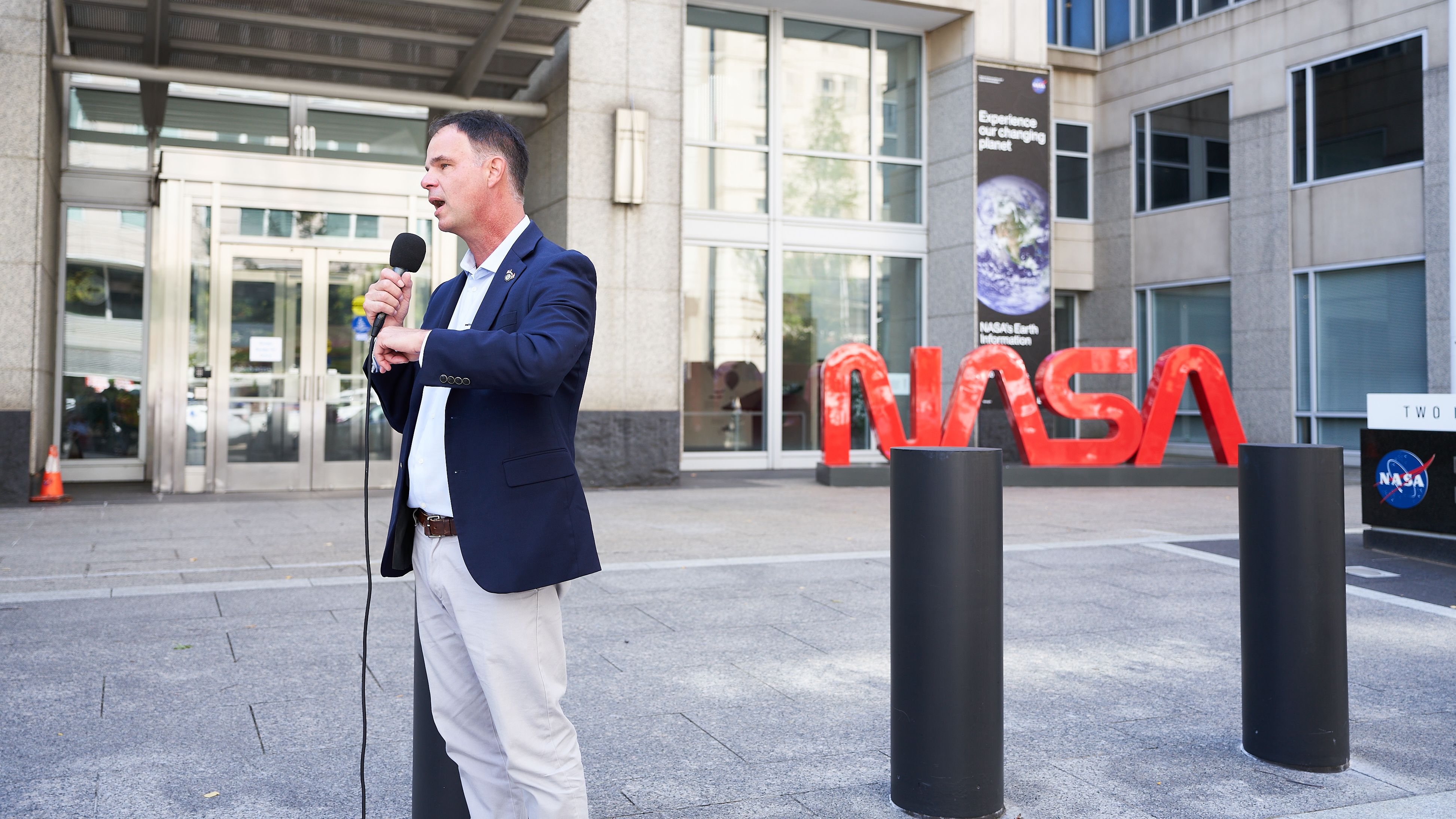
IFPTE President Matthew Biggs addresses protesters during a Sept. 15 demonstration outside NASA headquarters in Washington, D.C. (Image credit: NASA Needs Help)
“That’s supposed to make us work more efficiently? That’s just going to make all of us less safe,” Monica Gorman, a GESTA area VP, said to protesters outside NASA’s D.C. headquarters on Sept. 15. “It’s going to put NASA’s missions at risk, and it’s going to put NASA’s people at risk.”
At that same demonstration, representatives from GESTA’s parent body came to show their support. IFPTE President Matthew Biggs told those gathered that the union was already in the process of challenging the order in court. “It’s a lot easier to do RIFs if there’s no labor unions there to challenge them,” he said. “So we are going to challenge it in the courts, and we’re challenging it on Capitol Hill, and we’re going nowhere.”
Even if the unions have a case, the system is built against them, said Mark Gaston Pearce, who served as chairman of the National Labor Relations Board in the Obama administration from 2011 to 2017, and is the former executive director of, and currently a senior advisor at, Georgetown University’s Workers’ Rights Institute.
“There will probably be causes of actions that can be pursued, but the practical nature of these circumstances is such that these employees will need to continue to keep working,” Pearce said. “Funding these lawsuits are not a simple matter, and even if that is achievable, the time that would be taken for all of this to take place will be so, so long in the future that the immediate harm suffered could be insurmountable for many of the employees.”
Negotiations end, cuts accelerate
“The Engineering and Technology Directorate in particular, seemed like it was ignoring that guidance…”
— Peter
Trump’s executive order freed Goddard leadership of their obligation to debate with GESTA about facility closures and anything else. The union was given 48 hours’ notice to clear their resources from the conference room previously dedicated for their use, and employees were barred from congregating there during off hours.
Negotiations with GESTA stopped, and center leadership kicked their reorganization efforts into overdrive.
Despite media reports indicating that Acting Administrator Duffy directed NASA to begin working toward the budget outlined in the House Appropriations Committee’s bill for the coming fiscal year, which restored much of the science programs initially cut in the PBR, that direction was not one communicated through Goddard’s management levels to employees.
“There was certainly no widespread communication broadly disseminated to the workforce informing them that we would now be following the House budget request instead of the President’s budget request at Goddard,” said Peter, the GSFC civil servant. “That is unlike activities that I have seen through other centers.”
NASA officials maintain they provided appropriate guidance to agency centers and mission directorates, instructing each to spend according to anticipated budget appropriations in alignment with presidential priorities, and that the agency remains in full compliance with Section 505 Appropriations reporting requirements. Duffy and other agency leadership have repeatedly assured critics they intend to follow the law, and adhere to whatever Congress ultimately passes. He even said as much directly to lawmakers at the House Committee on Transportation and Infrastructure’s hearing on July 17, promising to “follow the will of Congress.”
“The Engineering and Technology Directorate, in particular, seemed like it was ignoring that guidance from headquarters and instead continuing to plan to the Presidential budget request,” Peter said. This would stand in direct contradiction to guidance passed down from NASA’s top leadership, Space.com has learned.
The “cost savings” closures initiated by Risko to align with Trump’s budget proposal expanded to include Goddard’s 20-year Master Plan, a vision for the center that began in 2017 and outlines upgrades, renovations and other changes to GSFC’s 1,270-acre (514-hectare) campus, including the demolition of older facilities and the construction of new buildings through 2037. It includes reducing the campus’s footprint by nearly 50%.
On Sept. 22, as worries over a looming government shutdown mounted in the face of deadlocked negotiations in Washington, Goddard Associate Center Director Raymond Rubilotta announced a rapid acceleration of the Master Plan from 20 years to six months.
“Beginning Wednesday, Sept. 24, we will initiate a series of moves at both campuses that will reduce our footprint into fewer buildings,” Rubilotta said in an email to Goddard employees, obtained by Space.com. “All planned moves will take place over the next several months and will be completed by March of 2026.”
An email on Sept. 22 announces the acceleration of Goddard’s 20-year Master Plan. (Image credit: obtained by Space.com)
Over the week that followed, employees described hectic disorganization. “People are being told to relocate offices on short notice, often chaotically with little planning. They are being told to highly prioritize the moves,” Wendy said.
There were instances of employees being assigned workspaces already occupied by others and unable to return to their original offices, buildings being emptied of personnel with no current plan to recover or relocate potentially millions of dollars of equipment left behind, employees told Space.com. “It’s crazy,” said Finch, the systems admin.
The long-term plans for Goddard’s main campus included the construction of nine new facilities, the renovation of 10 facilities and “divestment or partial divestment of 12 facilities, and the demolition of 61 facilities.” In this case, “facilities” encompasses everything from land, utilities, buildings and really any structure on NASA’s property.
While there is no current work underway to begin construction on any of the new facilities shown in the plans, almost half of the largest buildings marked for future divestment or demolition have been listed for abandonment by the March deadline — nearly everything west of Goddard Road (the red line), on this map provided to Space.com.
The slides below highlight which of the buildings planned for demolition by 2037 have been accelerated to the March 2026 timeline, and where planned constructions overlap.
Image 1 of 3
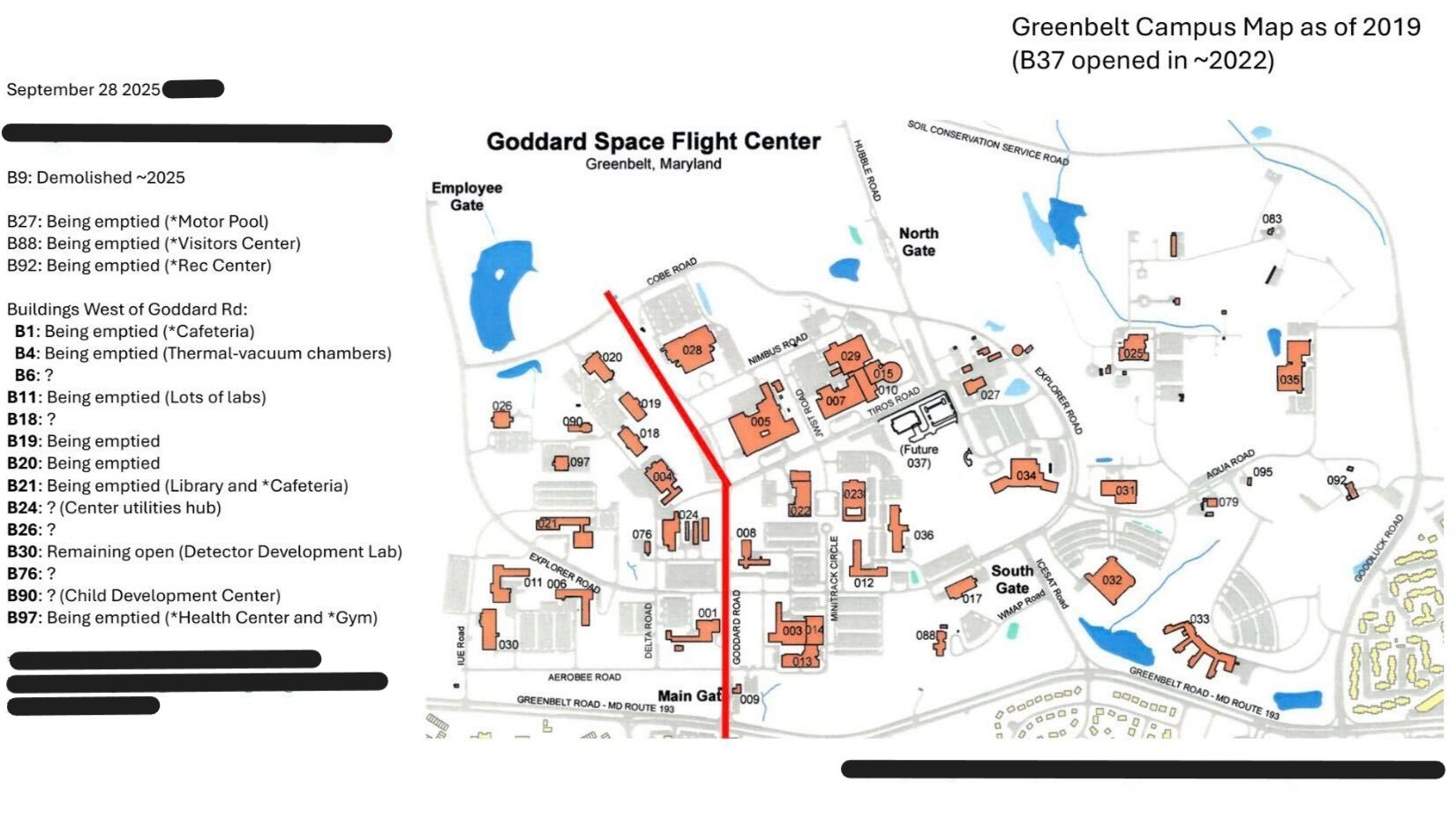 Buildings marked for divestment or demolition in Goddard’s 20-year Master plan. According to employees, nearly everything west (right) of Goddard Road (the red line) is on an expedited track to be closed by March 2026.(Image credit: obtained by Space.com)Expedited closures
Buildings marked for divestment or demolition in Goddard’s 20-year Master plan. According to employees, nearly everything west (right) of Goddard Road (the red line) is on an expedited track to be closed by March 2026.(Image credit: obtained by Space.com)Expedited closures
A map of planned closures taking place at Goddard through March 2026.
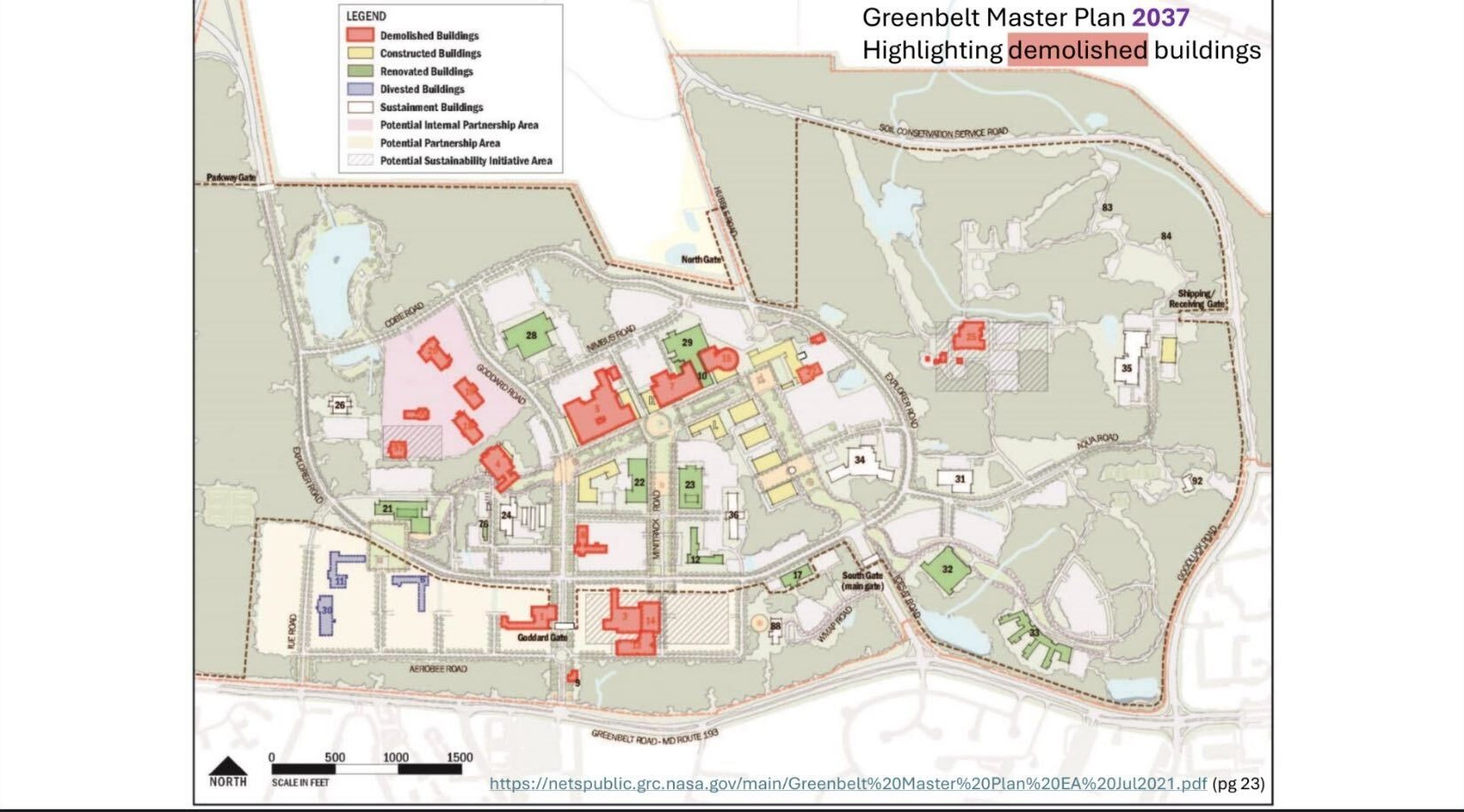 This map from Goddard’s 20-year Master plan shows planned demolitions to take place by 2037, many of which have been accelerated to just a few months.(Image credit: NASA)Planned demolitions
This map from Goddard’s 20-year Master plan shows planned demolitions to take place by 2037, many of which have been accelerated to just a few months.(Image credit: NASA)Planned demolitions
A map from Goddard’s 20-year Master plan showing planned demolitions to take place by 2037.
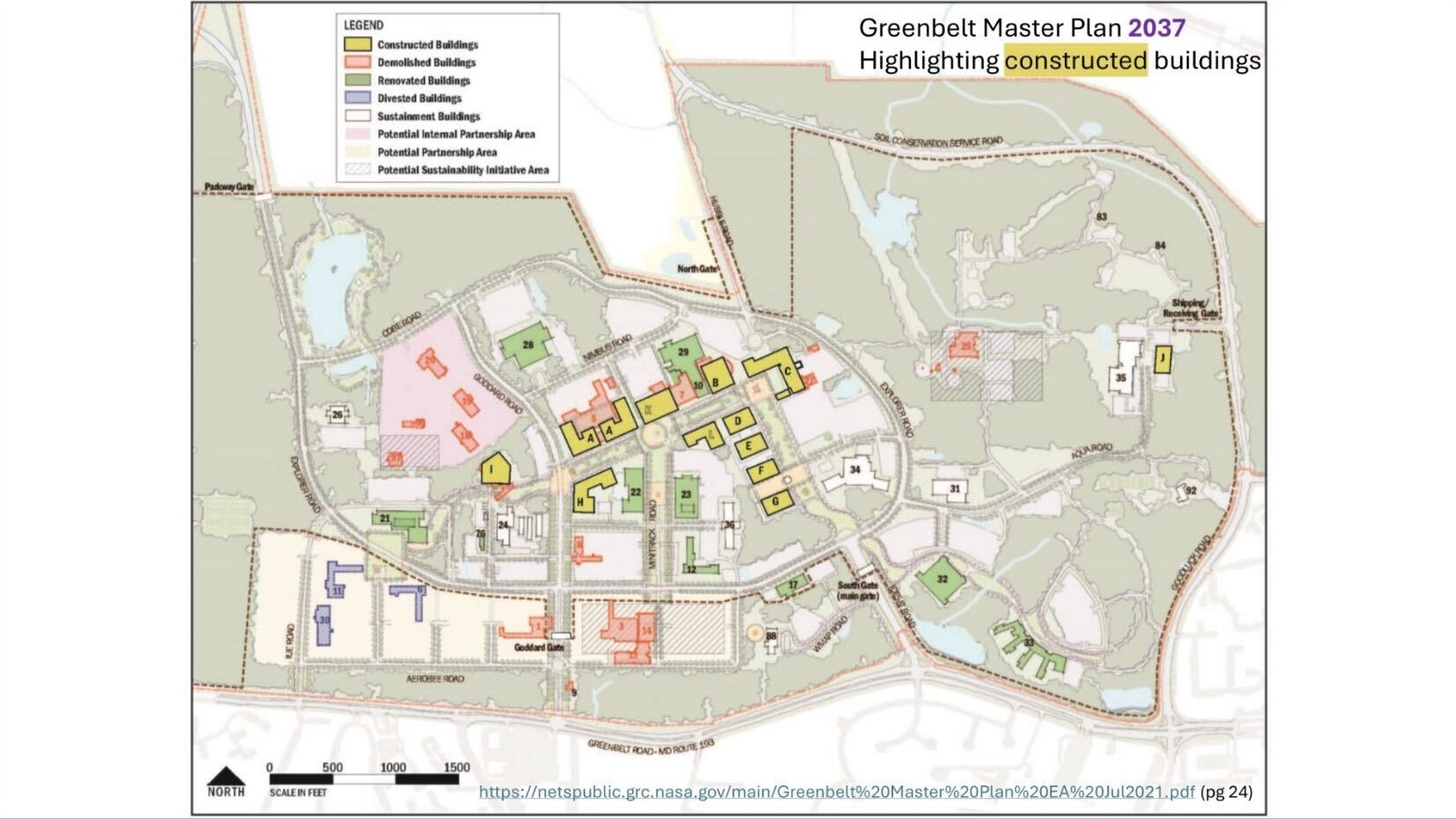 This map from Goddard’s 20-year Master plan shows planned constructions to take place by 2037, none of which have been completed or broken ground on during the accelerated closure of many buildings on the GSFC campus.(Image credit: NASA)Planned construction
This map from Goddard’s 20-year Master plan shows planned constructions to take place by 2037, none of which have been completed or broken ground on during the accelerated closure of many buildings on the GSFC campus.(Image credit: NASA)Planned construction
A map from Goddard’s 20-year Master plan showing planned constructions to take place by 2037.
For NASA, the staffing decrease as result of the DRP was one of the motivations behind ramping up building consolidations, which the agency assured are being methodically carried out in order to preserve the science and resources needed across projects. The buildings being vacated were apparently already 40% unoccupied, and a burdensome cost on center resources.
According to Wendy, if GSFC leadership is using the smaller workforce to justify the downsizing, the numbers don’t add up. “They basically want to move everybody out of half of the buildings on campus. Half of the physical footprint of Goddard. But we only lost about a third of our employees to DRP and attrition,” she said.
More than just a logistical challenge of physical space, the moves themselves seem to ignore the impact of what’s being left behind. “They’re being implemented in inept ways that do not properly account for how unique the technical work that has been done at Goddard truly is,” Peter said. “It seems that there is a lack of understanding in Goddard management in general as to what technical capabilities we have, and what’s actually important to retain them.”

Maps show Goddard’s 20-year Master Plan, with nearly half of the Greenbelt campus now marked for abandonment — a visual “hollowing out” of NASA’s flagship science hub. (Image credit: obtained by Space.com)Government shutdown
Days after Rubilotta’s Master Plan notice, OMB issued a memo, first reported by Politico, directing agencies to consider reduction in force notices during a shutdown for programs not aligned with the “President’s priorities.”
On Sept. 29, NASA updated the agency’s shutdown guidance to add a similar “presidential priorities” phrase, heightening employee fears that the administration would use the government shutdown as an excuse for further layoffs and project cuts.
Goddard’s leadership did not provide employees any center-specific shutdown instructions, according to employees. “They didn’t hold a single town hall — other [NASA] centers did — and didn’t send any guidance on what to do during a shutdown,” Wendy said. What they did send was “a big new re-organization email,” which came at 5 p.m. on the evening before the shutdown began.
“We are shutting down center capabilities with no plan to replace them…”
— Peter
Some groups received instructions to pack their work and equipment — in some cases, massive testing hardware — and were told to stand by for a notice with a 48-hour window to relocate.
“Active research and mission development has been greatly disrupted as some labs have been told to leave their buildings immediately,” McGrath said. “A very hard task to do when you have extremely sensitive equipment that isn’t just meant to be moved on a whim. So we are shutting down center capabilities with no plan to replace them in other lab facilities.”
While the government was closing its doors for business, Goddard’s management laid the groundwork to make sure theirs were deadbolted. “Raymond Rubilotta (Associate Center Director) and Segrid Harris (Director for the Engineering and Technology Directorate) are continuing to push the disassembly of Goddard Center at a rapid pace, even while the government is shut down,” McGrath said.
On Oct. 1, the first day of the shutdown, some staff were still being told to come pack their offices as part of their “orderly shutdown procedure,” according to an email sent that morning, obtained by Space.com, and that movers would relocate the contents if and when new workspaces were assigned. “Normally, the orderly shutdown activities are limited to things like getting your work into a safe state, setting automatic replies on your emails, and clearing out your fridge,” Wendy said.
An email from Oct. 1 instructs employees to pack up their offices and lab space during the government shutdown. (Image credit: obtained by Space.com)
“It’s being done essentially in secret, on compressed timelines, and it seems to be that the justification for doing so is under false pretenses.”
— Peter
As the shutdown continued into multiple weeks, Goddard leadership began designating select employees with part-time excepted status, deeming the consolidation of “technical work and employees” as a priority, and reinstating their furlough once their offices are packed.
For federal workers during the government shutdown, an “exemption” differs from an “exception.” Contracted movers paid from pre-obligated funds, for example, could be considered exempt, but federal civil servants would not. An exception, by contrast, allows employees to continue certain unfunded activities because they are necessary to protect life or property.
Only two exceptions have been approved for facility relocations during the shutdown so far at Goddard, Space.com has learned, and no office spaces were submitted as part of those requests. In fact, over 100 office space moves were put on hold specifically because of the government shutdown. However, employees needing to relocate their workspaces as a result of their laboratory spaces being moved did fall into the excepted category.
“It’s unclear what activity is really taking place under any officially approved status from headquarters at this point,” Peter said.
“It’s being done essentially in secret, on compressed timelines,” he added, “and it seems to be that the justification for doing so is under false pretenses, and the activities themselves may also be illegal due to Anti Deficiency Act violations of recalling civil servants from furlough.”
(Image credit: obtained by Space.com)
“The expectation will be to report onsite no later than Thursday October 16th to conduct packing of your office materials and any lab preparations,” reads an Oct. 14 email to employees, obtained by Space.com. Employees were given three business days to do so, according to the email, and informed that, once packed, their offices’ contents would be moved to “offices and labs as they are ready.”
“I think one of the intents of the master plan was to move people out of buildings that were falling apart, but we have not built new buildings to move those people into, and we don’t have lab spaces available,” Wendy said.
Employees on some teams were told that if they were unable to complete evaluations of their lab equipment, whatever wasn’t designated give-away or keep would be thrown out. “All items not marked in labs by COB Monday 10/20 will be excessed,” an Oct. 16 email, obtained by Space.com, said.
“There’s equipment that is being planned to just be abandoned in place,” Wendy said.
The ElectroMagnetic Anechoic Chamber housed in Building 19 at NASA’s Goddard Space Flight Center in Greenbelt, Maryland. (Image credit: NASA)
All that hardware adds up. Peter said losses will include “tens of millions of dollars and decades’ worth of investment in these facilities that historically have been considered core to Goddard’s capabilities.”
Take, for instance, Building 19, which houses the Goddard Electro-Magnetic Anechoic Chamber for testing antennas and other microwave devices used on spacecraft, communications laboratories, hardware assembly rooms and the avionics laboratory, among others.
Of Building 19’s infrastructure, at least eight laboratories have been completely divested without replacement, with some still needed to support critical functions for ongoing or upcoming missions, according to Peter.
So far, at least four sites on Goddard’s campus have already been impacted, including Buildings 20, 30 and 32, as well as Building 19, which, as of Oct. 24, was “emptied of all government and personal property and is being locked and made inaccessible,” Peter said. There is speculation about which will be next, he added.
The cost of moving
Many scientists and engineers track their time and workload according to the projects that work is associated with, including missions based out of other NASA centers. This allows NASA to track costs across multiple missions, funding sources and facilities nationwide. Employee hours are tracked under a different “charge code” during a government shutdown, however.
For employees packing up and moving their offices during the shutdown, though, “they’re being told to charge their projects,” Wendy said. According to her, this could lead to a situation where a mission based out of Johnson Space Center, for example, is paying for part of Goddard’s employee relocation efforts, making the actual cost of work being done during the shutdown harder to track.
Offices are being emptied inside buildings around Goddard, with files, equipment and personal belongings discarded in the hallways. (Image credit: obtained by Space.com)
“If there’s ever a cost-benefit analysis of how much money we’re saving, versus how much money we’re spending and losing by throwing stuff out, that won’t be tracked accurately,” Wendy said.
Marking those hours under certain mission costs like this will hit some harder than others.
“Some of these are independent research projects that people have worked really hard to propose funding for,” Wendy said. “It’s a very limited pot of money that they have … and they’re being asked to spend that money on moving their lab.”
An uncertain future
The feeling that Goddard is being targeted has been hard to shake for those working within its walls. “Seems like Goddard is giving up on its future, whether that is being forced by headquarters, OMB and the White House, versus management not doing a good job protecting it. Some people are speculating that NASA is using Goddard as a sacrifice to preserve the rest of the agency,” Wendy said.
Green, who worked at NASA through several administrations before becoming Chief Scientist, says the space agency has weathered turbulent times before. “NASA has gone through, in my 42 years as a civil servant, huge changes. We’ve had many buyouts. We’ve had huge hiring freezes. We have had RIFs,” Green said, and offered advice to the NASA employees currently riding out the storm:
“Stay the course. Keep doing what you’re doing. Don’t anticipate you won’t be doing it tomorrow, until you’re told you won’t be doing it tomorrow, but then also be flexible … If you’re not taking that knowledge and connecting it to something else that you can go to, that’s a problem.”
That course may now be much more difficult to navigate as employees steer the murky waters of a management hierarchy they feel doesn’t support them. And, whatever Congress ultimately passes may indeed no longer matter. The damage at Goddard is already being felt in lost expertise, dismantled facilities and the quiet unraveling of the center’s safety infrastructure.
The welcome sign outside NASA’s Goddard Space Flight Center in Greenbelt, Maryland. (Image credit: Space.com / Josh Dinner)
With projects bracing for termination, mission teams broken apart and safety protocols weakened, the guardrails that once kept NASA from repeating its worst tragedies are being stripped away in real time. Labs are being shuttered faster than they can be reestablished, institutional knowledge is walking out the door faster than it can be replaced and the foundation that once made Goddard the center of NASA’s scientific excellence may never regain the depth of comprehension and capability it once held.
As Goddard is hollowed from within, center scientists and engineers like Wendy and Peter can’t help but feel deflated.
“Regardless of how priorities may shift at Goddard in terms of what kinds of work we support, what is an absolute certainty at this point is that we as a center will be incapable of supporting as many types of work as we have historically,” Peter said.
Wendy sees implications beyond just Goddard and NASA.
“I think it just kind of speaks to the atmosphere of the agency and the nation,” she said, “where people are like, ‘Well, laws don’t matter for the people at the top anymore.'”

